Leica M Type 240 Digital Rangefinder Camera - Page 32 Index of Thorsten Overgaard's user review pages on Leica M9, Leica M9-P, Leica M-E, Leica M9 Monochrom, Leica M10, Leica M10-P, Leica M10-D, Leica M10-R, Leica M10 Monohcrom, Leica M11, Leica M11-D, Leica M 240, Leica M-D 262, Leica M Monochrom 246, Leica SL, Leica SL2, Leica SL2-S, Leica SL3, Leica SL3-S as well as Leica TL2, Leica CL, Leica Q, Leica Q2, Leica Q2 Monochrom, Leica Q3 and Leica Q3 43:
By: Thorsten Overgaard. June 28, 2013. Last edited August 15, 2023.
Add to Flipboard Magazine.
Seeing with the Leica M 240
With both the traditional viewfinder, the new electronic Live View viewfinder and a new sensor, there was plenty to learn about the Leica M 240. Strong tradition meets new technology. What we had become accustomed to call the "Leica M9 look" with the same regard as if it was Simon and Garfunkel singing their praise to Kodachrome ... it is all gone.
Or is it?

The great CMOS vs. CCD sensor war
When the Leica M9 was presented in September 2009 many criticized the use of CCD sensor. But after a while the world seemed to change and people liked the "Leica look" of the Leica M9 CCD sensor.
But when Leica announced that they would use a CMOS sensor in the Leica M 240 many criticized the use of a CMOS sensor. The criticism even went so far that on the Leica Camera Blog people started commenting on the obviously bad qualities of the new Leica M Type 240 sensor already in February 2013, based on photos they wrongfully thought were the CMOS (but was in fact the Leica M9 with a CCD sensor).
My viewpoint is that if one can get a camera and sensor to produce the images one wants, it's a good sensor.
And to me that is the case with the CMOS sensor in the Leica M 240. It works.
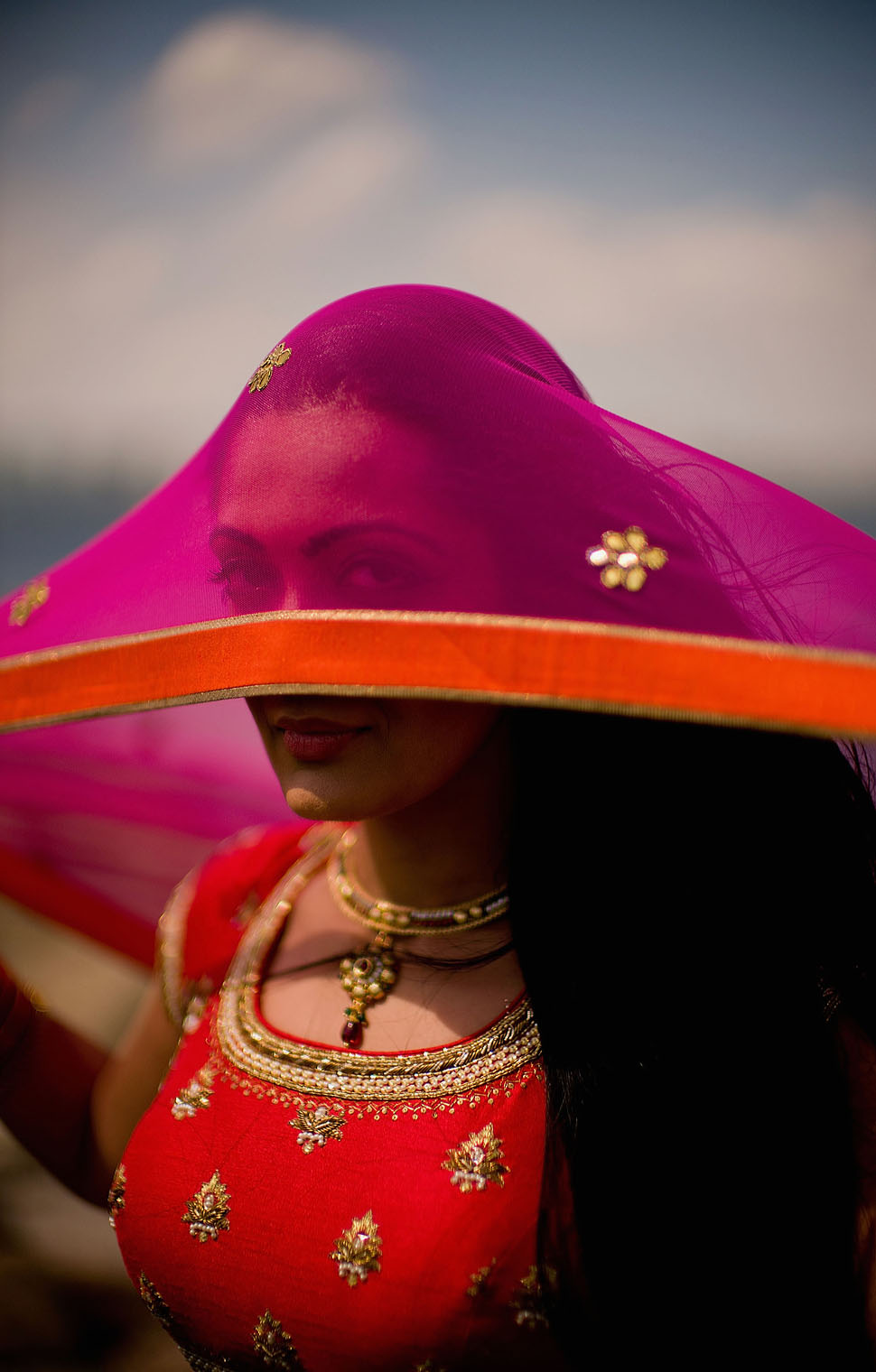
Indian Bollywood-actress, Miss Kolkata and Miss Universe India 2010, Sheena Chohan. Denmark, June 2013. Leica M 240 with Leica 50mm Noctilux-M ASPH f/0.95.
Reasons to use a CMOS sensor
The CMOS sensor has the advantage that is is more economical to produce, goes higher in ISO, uses less battery and can be used for Live View and video.
The CCD sensor has less 'noise' pattern than CMOS and is the sensor used in practically all medium format cameras. The camera types one would characterize as high-end professional cameras. CCD uses more power and can't be used for video or in a Live View camera.
One of the reasons CCD looks so film-like is that the noise pattern is completely randomised. On CMOS it is uniform and you can always notice the fixed pattern of noise imprinted on the image. A CCD sensor has grain like film and it moves in the same way as film grain.
CCD sensors dump the data as one package, whereas CMOS drops lines; this is the reason one can experience 'rolling shutter' on video images made with CMOS. The subject or camera moves between the top lines and the bottom lines of the image are recorded, creating for example zigzag lines (see the Page 36 of this article about video).

Bon appétit au Paris. Leica M 240 with Leica 50mm Noctilux-M ASPH f/0.95.
| |
|
|
|
|
| |
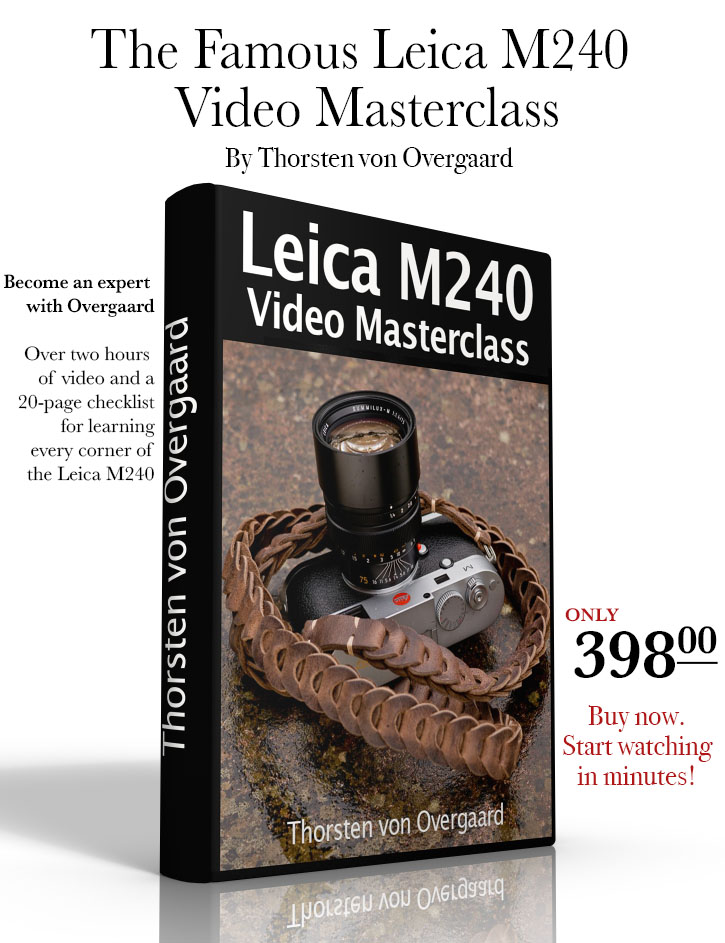 |
|
| |
|
|
|
|
| |
Full Leica M240 Pack:
Video Masterclass
+
Street Photography Masterclass
All about the Leica M240 video instruction masterclass (17 videos)
+ Street photography video masterclass
filmed in New York (11 videos).
+ 8 Bonus videos
+ Styles for Capture One for Leica M240
+ Lightroom Presets. for Leica M240
Normal price $1,192.00
Save 60%
Only $476.00
USE CODE: "ILOVEM240"

Order now. Instant delivery.
100% satisfaction or money back.
Item #1844-1848-0823 |
|
Leica M240
Video Masterclass
Two hours of video class
with Thorsten von Overgaard
+
20-page checklist for learning
every corner of the Leica M240.
For Computer, iPad or smartphone.
More info
Only $398.00

Order now. Instant delivery.
100% satisfaction or money back.
Item #1844-1017 |
|
| |
|
|
|
|
History might repeat itself
Nobody can know how the Leica M Type 240 would work if it had used an updated CCD sensor. But we do know a great deal more about how the Leica-modified CMOS sensor looks at this point. So far users like the dynamic range, the colors and the higher ISO capabilities.
I will use Leica M9 at 800 ISO as the maximum speed to ensure my colors are always right. The Leica M 240 I will use at 3200 ISO as the maximum as the colors are correct there. I sometimes have a thin white line in the image at 2500 and 3200 ISO under extreme low light conditions. The reason for those thin vertical lines is that my sensor has to be remapped (which Leica Customer Service will do under warranty).

Brooklyn Bridge, New York, June 2013. Leica M 240 with Leica 21mm Summilux-M ASPH f/1.4
I basically haven't decided what my highest ISO ultimately will be, 3200 ISO or 6400 ISO. And I haven't found a final workflow to deal with the colors. I know that when I do manual white balance the colors are very close to how I want them. I find the red and the warm tones a bit too warm and optimistic some times, but that I can adjust (with the Leica M9 I will usually desaturate the red -10 and the orange -30 to get the colors - and mainly skin tones - correct).
It is likely that Leica Camera AG will address the colors in their next firmware update / camera profile update in Lightroom. The ideal would be the Leica S where the colors are so precise and natural that hardly anything has to be adjusted in Lightroom (when white balance has been set correctly from the beginning).

New York, June 2013. Leica M 240 with Leica 50mm Noctilux-M ASPH f/0.95.
Higher rate of color photos
What I have noticed so far is that I tend to keep more images in color with the Leica M 240 than with the Leica M9, and that is for me a sign that colors work very well on the Leica M 240.
I will get back at a later point with more on shooting and editing pictures (in both color and black and white).
| |
|
|
|
|
| |
Buy the new eBook
"A Little Book on Photography"
by Thorsten von Overgaard |
|
| |
|
|
|
|
| |

Order now - Instant delivery.
More info
★
★
★
★
★
★ |
|
It's a humorous understatement to call this
new eBook by Thorsten Overgaard for
"A Little Book on Photography".
It's a grand book, a history lesson, life experience, a biography and poetry book and brilliant photo book!
All in one beautiful package of 180 pages
to fire you up and get you to love
photography ... unconditionally!
"A Little Book on Photography"
eBook for computer, Kindle and iPad.
New release March 2017.
Intro price only $47 - 180 pages.
| |
|
|
| |
Buy Now

Instant Delivery |
|
| |
|
|

|
|
| |
|
|
Also Leica glass in front of the sensor
It's a little fantasy of mine to try to imagine how it must feel like to be a sensor covered in small micro optics made by Leica. Which is what the sensor is. To see the world through Leica glass in those small precious moments where the shutter is activated and the metal curtain separating you from the light goes up for 1/2000 of a second - ah! - or longer to let the light come through.
Or - lo and behold! - turn on the Live View so the metal shutter is up and the light shines bright onto my little sensor beingness for a longer while.
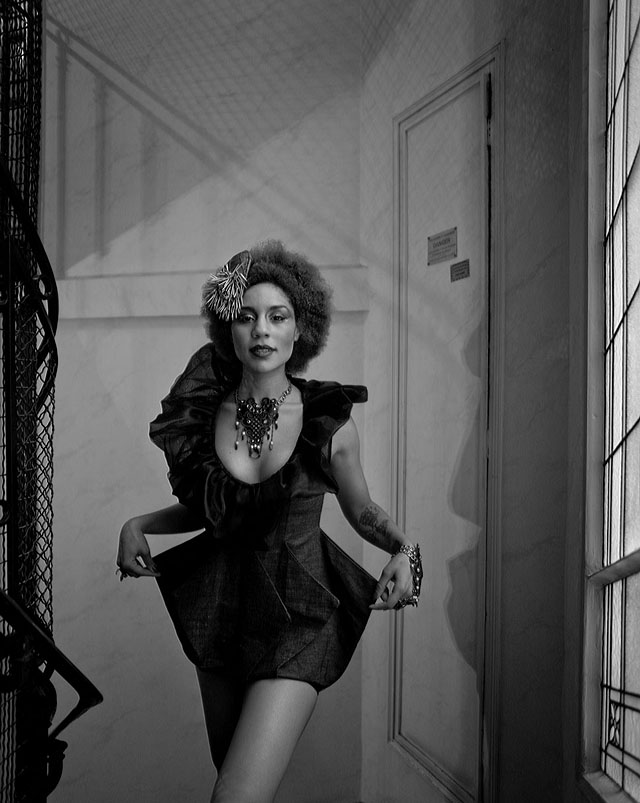
Paris, April 2013. Leica M 240 with Leica 21mm Summilux-M ASPH f/1.4 at 800 ISO, 1/60 second.
The reason why Leica Camera AG designed the glass in front of the sensor for the Leica M9 was that it was the only way to 'bend the light'. The lens in Leica M cameras (meaning every M camera from M3 to M9) is so close to the sensor plane that the light rays travel in a too steep angle in the outer edges of the sensor. This, if you were following the discussions around 2008-2009, was the reason it was stated that a Leica could never be a full-frame camera. That is, until the Leica M9 surprisingly was released on September 9th, 2009 at 9:09 AM in New York.
I don't believe the Leica M8, Leica DMR, Leica Digilux 2 or any of the Leica X or Leica D-Lux cameras have special Leica designed optics in front of the sensor. If anyone know I would be happy to know more.
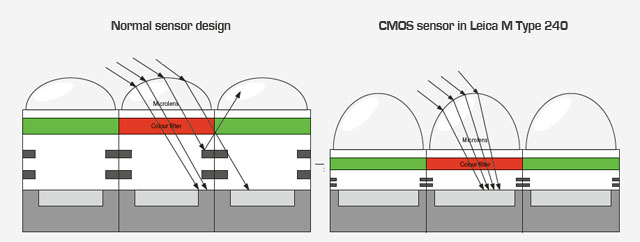
Being a sensor in a Leica M Type 240 body must be something special. Sensorium ("seat of sensation" from Latin). The first sensor from the CMOS family to ever set foot in a Leica M body! Also note that the Leica M Type 240 sensor does not have an AA filter in front of the sensor.

The analog rangefinder or viewfinder ("Meßsucher")
The "Messsucher" (which is German "Meßsucher" for "Rangefinder") is the reason the Leica cameras were named M.
Today M is more a line of cameras, the M series, that all take lenses with the M bayonet.
In 1954, Leitz (Ernst Leitz Optical Industry as Leica Camera AG was called then) presented the Leica M3 introducing the new Leica M bayonet mount replacing the screw mount. The new camera also combined the rangefinder and viewfinder into one large, bright viewfinder with a brighter double image in the center. The analog viewfinder as we know it today was born.
The analog viewfinder on the Leica M Type 240 is still the crown jewel of the camera body. Nobody else delivers a camera with anything like this! The finest piece of engineering, from an era where the whole Leica camera body was engineered without a single bit of electronics, or even electrical parts (as of 1964 when the brand-new Leica M4 came out, no battery was necessary for photography).
Anyone who has looked through a Leica viewfinder, a Leica loupe or a pair of Leica binoculars, knows what I mean when I say that Leica glass looks so bright and clear it is a pleasure.
The Leica glass, in my opinion, has the extra advantage, that the view looks relaxed and natural. Yet brighter and clearer than what the naked eye sees.
Leica has been working with optics since 1849 when the Optical Institute was established in Wetzlar in Germany (named Ernst Leitz Optical Industry in 1869) though they did not make camera lenses till 1908. The experience since then is accumulated in the more than 2,000 glass patents Leica Camera AG have.
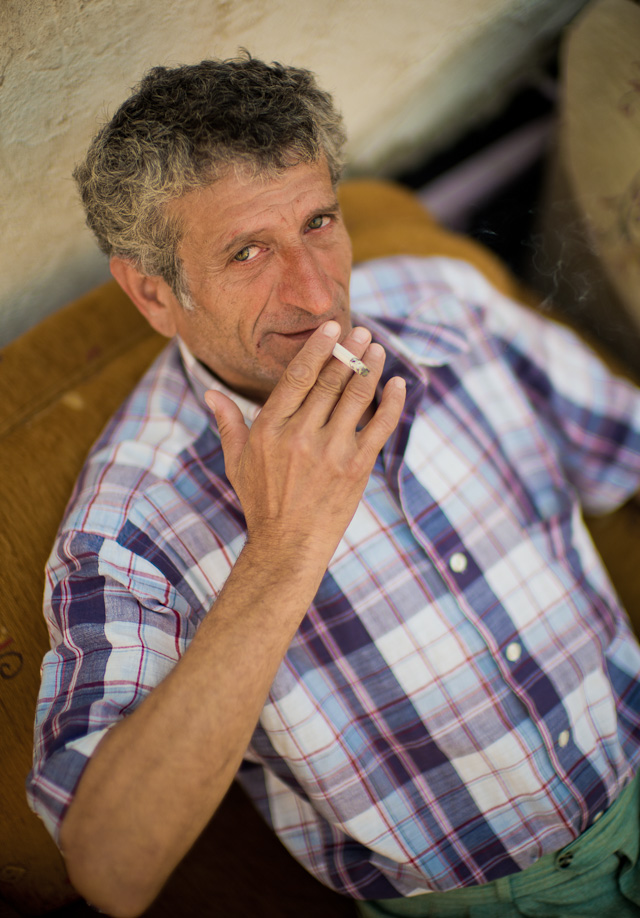
The Marlboro Man. Istanbul, May 2013. Leica M 240 with Leica 50mm Noctilux-M ASPH f/0.95.
The analog viewfinder should be enjoyed as it is an essential part of the Leica M. Not only does it include marvelous optics, it is also a piece of engineering marvel as it helps you focus.
If you take off the lens of a Leica M camera and look, you will see a small chrome wheel on the top inside the bayonet opening. You can push this back and forth gently with a finger and this will change the position of the center image inside the viewfinder (the one you use for focusing).
If you then look at the lenses back end (that is normally inside the camera) you will notice that the metal tube moves back and forth when you move the focusing ring on the lens. This is what pushes the chrome wheel inside the camera back and forth slightly, which then again moves the prism in the viewfinder slightly so you can find the focus by having the two images in the center of the viewfinder match.
If you then turn around and look five meters in the direction of where the camera is pointing, and then imagine how this tiny mechanism enables you to focus with a few centimeters precision at something five meters away ... then the wonder of this analog viewfinder should hit you.

Girl talk at Lower West Side, Manhattan, New York, June 2013. Leica M 240 with Leica 50mm Noctilux-M ASPH f/0.95
I bet some young auditor, wet behind the ears, who found himself working at Leica Camera AG in Germany would love to exclude the analog viewfinder from the camera and thus save the company for a very expensive piece of technology, that nobody else in the camera industry suffers from having.
The analog viewfinder is a very expensive part of the Leica M that could easily be replaced by an electronic viewfinder. And maybe it should one day. It all depends how we percieve the new technology, and in the Leica M Type 240 we for the first time have the possibility to look into the future and compare the alternatives.
Better Meßsucher on the Leica M 240 than Leica M9
Many Leica M 240 users have reported that the analog viewfinder on the Leica M 240 is easier to focus precicely with than the analog viewfinder on the Leica M9, Leica M9-P, Leica M-E and the Leica M Monochrom. In fact, all previous viewfinders.
There is no official change in the viewfinder, except that the body of the Leica M 240 has been completely made from new and is not the same as the Leica M9. Also, that is my take on it, it may give better eccuracy for the prism in the viewfinder that the frame lines are now artificial lit by LED light (whereas before the light for the frame lines were taken in from an additional vindow).
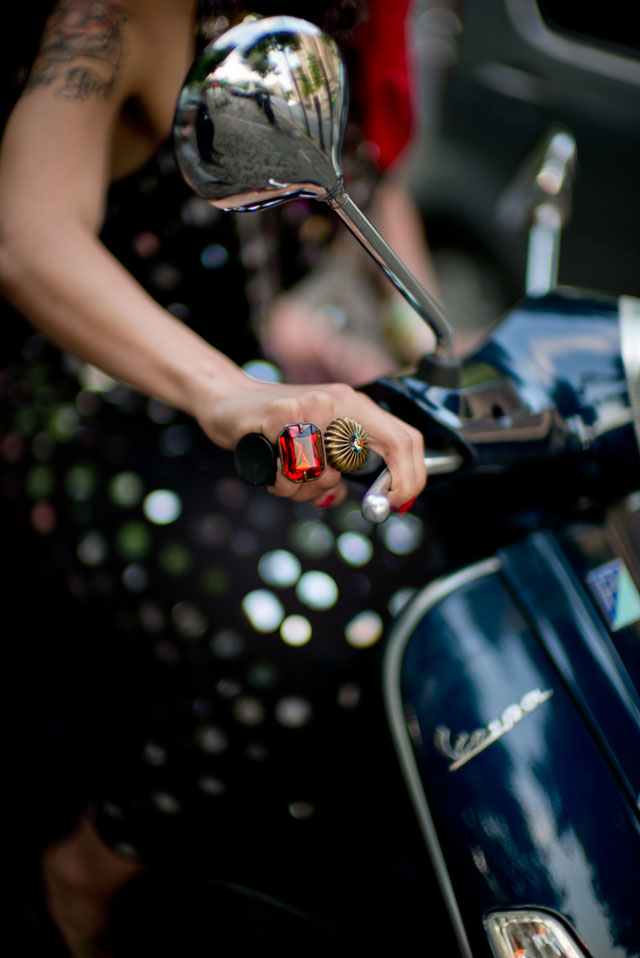
Photographing jewels by Géraldine Valluet in Paris. Blue Vespa LX 50 in the background. Leica M Type 240 with Leica 50mm Noctilux-M ASPH f/0.95.
The electronic viewfinder EVF (Electronic Visioflex Finder 2)
One of the things you want to get a hold of for the Leica M Type 240 is the EVF2, which is a rebranded Olympus VF-2 for Leica Camera AG to fit the Leica X2 and the Leica M Type 240.
When I say get it, I mean get one. But don't start using it till you have gotten used to the camera.
Whatever ... we both know you will start using this within 10 minutes after UPS drops off the box, no matter what I say.
However, I will say - as a disclaimer - that if I had known what I do now, I would have used my Leica M 240 the first two weeks without this ... instead of 5 minutes after I opened the box.
The electronic viewfinder can be an essential tool also when not using R lenses or doing Macro.
Real time DOF (depth of field)
Where the Leica M teaches you to 'see' an image mentally before you get it, the EVF2 has the beauty of seeing the image realtime as it will look. Suddenly, you can preview how the Leica 50mm Noctilux-M ASPH f/0.95 draws the light and the out of focus areas. This is a whole new thing and can of course be a help in composing in the 3rd dimension; which is what DOF (Depth Of Field) is. It is how you use selective focus to make a stronger message, as well as it is a way to add aesthetics to an image. Now you can see it in the viewfinder.
Great for Leica virgins to learn Leica
The EVF2 is the perfect introduction to Leica rangefinder cameras. Anybody can learn to focus it rather quickly, and even the waiter at the restaurant can be left the Leica to take a photo that is in focus. A task that was really difficult without the EVF2 as you had to set the focus and then let the person understand not to move the camera.
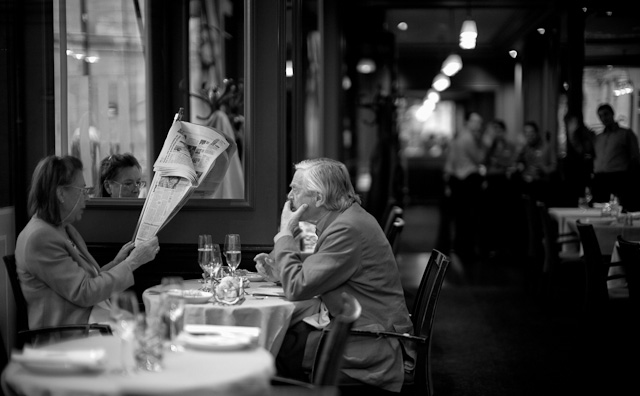
Have you heard the news? Paris, April 2013. Leica M 240 with Leica 50mm Noctilux-M ASPH f/0.95.
Precise focus with Focus Aid
The EVF2 is a very neat piece of electronics to look into. You have the undistracted view of the image at a large size ratio (the image fills your whole field of view). All information about exposure, ISO and metering mode is available in the viewfinder.
When you turn the focus ring on the lens, the view will change to Focus Aid which (in my case) is 5X or 10X. This makes it very easy to focus precisely and is what I use when I want precise focusing.
When focusing, you use the thumbs scroll wheel to adjust the enlargment from 1X to 5X or 10X while you view the image in Focus Aid (whichever X-factor you set it to it will stay till you change it. Next time you focus it will be the same enlargment).
Focus Peak
Focus Peak are the red lines around the edges of what is sharp. Those are seen on the EVF2 and on the preview display on the back of the camera when you use Live View. I will say though that it is not that often the red edges are in play. They seem to require a lot of light contrast (and highlight) to be visible. Simply having the Focus Aid set to 5X or 10X is a much better chance to get it right.
The great thing about the EVF2 is definitely the precision in focusing.
One Leica EVF-2 works for all wideangle lenses
Also the EVF2 makes it possible to see the full frame precisely when using any lens, including the wideangle lenses and the tele lenses.
For wideangle you don't need the analog viewfinder on top of the camera anymore, and for tele lenses the field of view is not limited to the small center of the viewfinder. What you see is the full frame, no matter which lens.
The EVF2 is also what makes it possible to use macro rings and to use a R-to-M converter or Nikkor-to-M converter and so use any other lens on the Leica M. Because Live View shows you what the camera sees and enables you to focus any lens or piece of macro equipment you can mount on the camera.
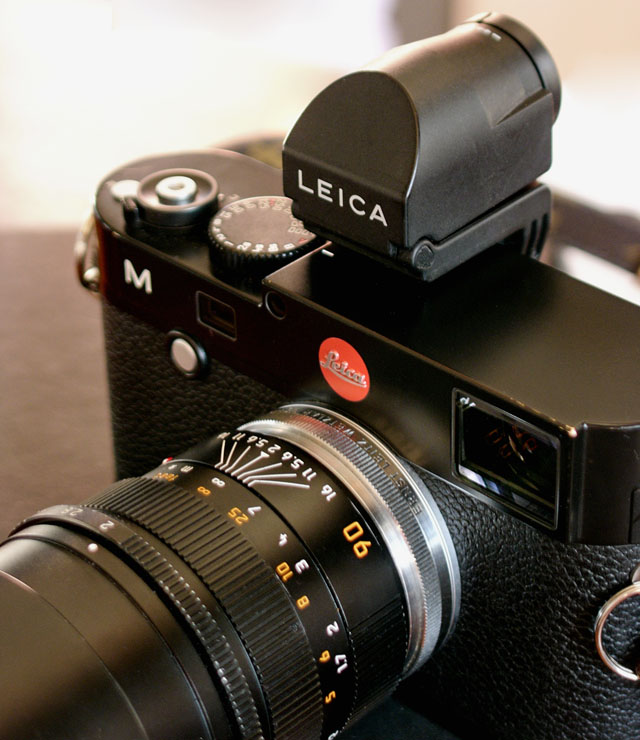
OUFRO on the Leica M Type 240 for macro. OUFRO is an original Leitz Extension Ring (produced 1959-1983 as part no. 16469Y). OUFRO can even be stacked for greater magnification and will work on the Leica M Type 240 as macro for all lenses, including the Noctilux, 90mm APO-Summicron-M ASPH f/2.0 (as shown on this picture) and even 21mm lenses. With the EVF2 and Live View you see the image crisp and sharp.
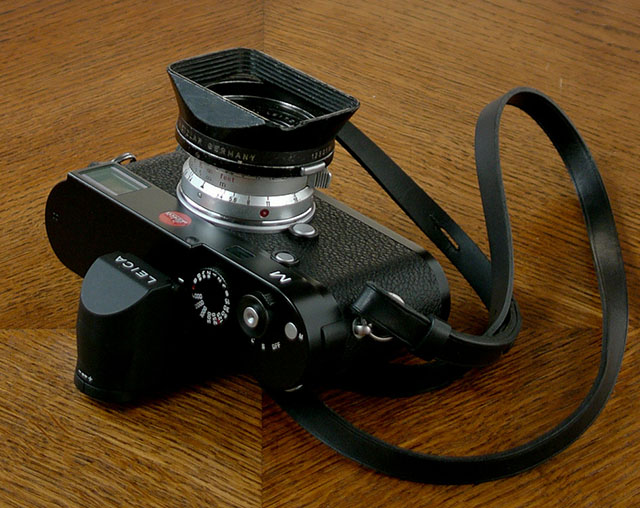
Old 21mm lens from 1964 making a comeback? With the EVF2 viewfinder attached in the hotshoe on the top of the camera, working with wide angle lenses will no longer require the analog viewfinder. Also a lens as the Leica 21mm Super-Angulon-M f/3.4 may experience a comeback. This 21mm lens is known for going so far back into the camera that it shadows for the light metering in the Leica M9. But in the Leica M Type 240 the metering in Live View happens from the sensor, and the real-time image is viewed in the EVF2. Voila!
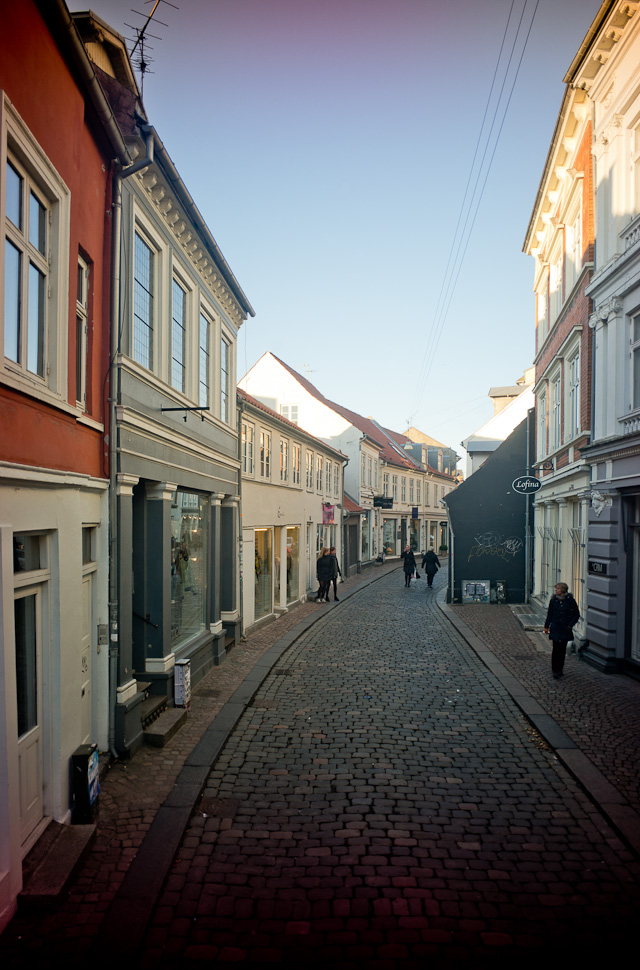
Denmark, May 2013. Leica M Type 240 with the old Leica 21mm Super-Angulon-M f/3.4 from 1960's. It still has some funky colors in the edges. But it works.
Easy to carry on the camera
Contrary to what I had expected, the EVF2 is easy to carry on the camera at all times. It is not bulky, it is not in the way, it doesn't fall off. It works very well having it sitting on the camera all the time. The build quality is not like the Leica M 240 so I do expect to go through more EVF2's than M240's.

Bat out of Hell. Berlin, May 2013. Leica M Type 240 with Leica 50mm Noctilux-M ASPH f/0.95.
 |
|
 |
 |
|
 |
 |
Medium |
 |
EVF Brightness |
Medium low |
 |
Frameline Color |
Red |
 |
Focus Peaking |
On |
 |
Focus Aid |
Automatic |
 |
Histogram |
Standard |
 |
Clipping Definition |
2 / 253 |
 |
Auto Review |
1 s |
|
 |
 |
 |
 |
|
|
 |
|
 |
Exposure Brightness adjustment of the EVF2
The brightness of the EVF2 is brighter than the display. Therefore adjusting exposure using the EVF2 is a little tricky. I have set the "EVF2 Brightness" to "Medium Low" in the menu to get some alignment of brightness between the display and the EVF2.
Delay
When using Live View you have to wait 1-3 seconds for it to turn on when the camera is turned on or woken up from power off. If you always have the camera on so it goes to sleep after two minutes, you press the shutter release slightly to turn the camera on when you see something interesting, and then the camera and Live View will be ready by the time the camera reaches the eye.
With the SanDisk 32GB 95MB/sec card the EVF2 will take 2-3 seconds to get ready. With the 64GB 95MB/sec card it is twice as fast. So get the 65GB card just for that reason.
 Leica 21mm Summilux-M ASPH f/1.4 sample photo" width="640" height="396"> Leica 21mm Summilux-M ASPH f/1.4 sample photo" width="640" height="396">
West 4th Street Basketball Courts. New York, June 2013. Leica M240 with Leica 21mm Summilux-M ASPH f/1.4.
What will make you consider switching between the EVF2 and the analog viewfinder is that when you focus with 10X magnification you get the glory of complete sharpness, and then when you press the shutter release slightly you get the view of the full frame and can compose the frame and shoot. However, there will be a built-in short delay from focusing to getting the full view so you can frame and shoot, and in that time the subject might have moved.
It is interesting how quick you get used to the EVF2 and lose confidence that you can ever focus with the analog viewfinder again.
But when you leave the EVF2 at home or in the bag for a day, you will realize how quick, bright and intuitive the analog viewfinder works. It is very natural to use.
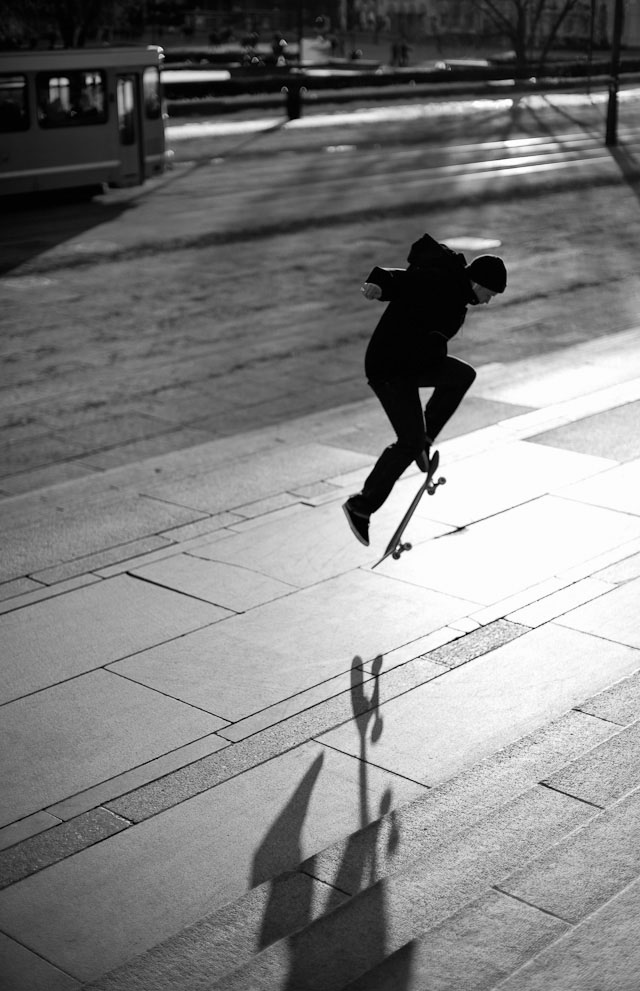
Skating in front of the Oslo City Hall, March 2013. Leica M240 with Leica 50mm Noctilux-M ASPH f/0.95.
How to do this at f/0.95 with narrow focus: Focus on a spot and set exposure manually so all you have to do is wait till a person walks into the focus. Then shoot. It may take several or many shots to get one that works. But the chances that you can follow-focus and get it are not that high.
The EVF2 has that advantage that you get razor sharp images. It will raise your standard for how sharp a Leica M image can be. If your camera is adjusted you can get razor-sharp images with any lens. But as soon as you strart fumbling with the focus or the camera is actually out of adjustment, the EVF2 will still get it razor sharp.
For portraits the analog viewfinder is gold. You stay in contact with the subject at all times and can observe every little change and shoot with very high precision as to timing. In portraits timing is essential. But when you switch to the EVF2 you lose that contact. You focus and there will be an instant where you lose contact and perhaps you or the subject moves slightly so you actually also lose the focus. But after you shoot there will be a second of still image preview in the viewfinder blocking the Live View of the subject.
So there are advantages with using the EVF2, and there are also disadvantages. When I shoot portraits I sort of go with what I have (with or without EVF), but some times I have decided to shoot with the analog viewfinder to get the right expressions ... and then do some 'back-up' portraits with the EVF2 to have some that are really sharp. Timing and expression of personality is essential in portraits, but also sharpness of the eyes.
 Taking the chick to town. Istanbul May 2013. Leica M Type 240 with Leica 50mm Noctilux-M ASPH f/0.95. Taking the chick to town. Istanbul May 2013. Leica M Type 240 with Leica 50mm Noctilux-M ASPH f/0.95.
Night vision
A handy thing is that the preview in the EVF2 is always 'daylight' even when there is not much light. When you press the shutter release button slightly down you will get the actual exposure preview. This is very handy compared to having to find focus with the traditional viewfinder in dark locations. It basically turns you into a superhero (as far as focusing is concerned).
Dirty glasses from the rubber
The EVF2 is not a great piece of industrial design. Where the analog viewfinder of a Leica M has a hard ring of plastic around it to protect glasses, the EVF2 has a large soft rubber ring that will leave grease on your glasses. So if you wear glasses, always bring a microfiber cloth with you to clean the glasses. I always carry a microfiber cloth with me because that is what I use to clean the camera, lenses and filters (and to wipe off rain as well).
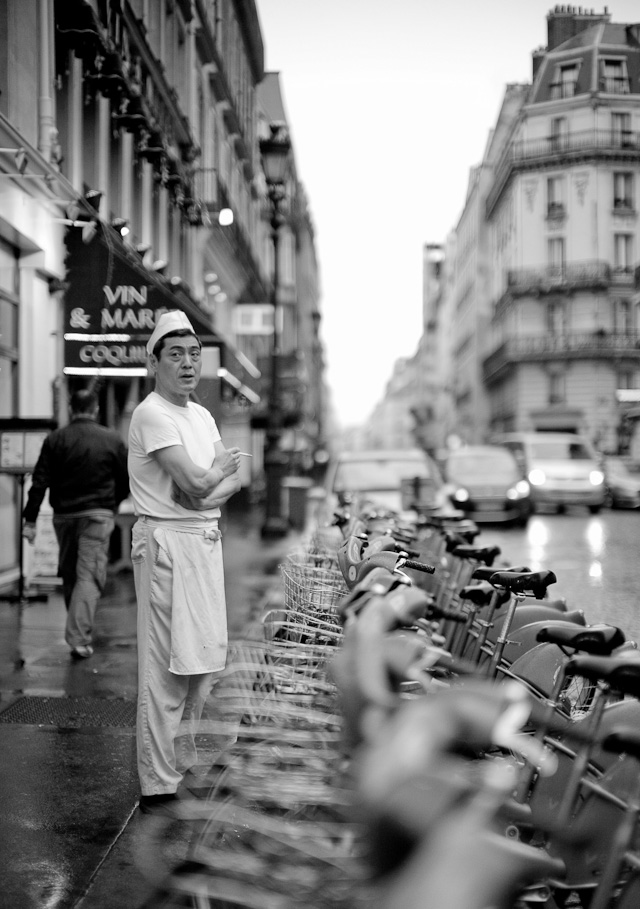
Chef on a break. Paris, April 2013. Leica M 240 with Leica 50mm Noctilux-M ASPH f/0.95.
Gluing the diopter
Another thing with the EVF2 is that the rubber ring also works as diopter when you turn it. It has a small mark you can feel with your fingers that has to be at 0 in the top for it to be normal. And then you can turn the ring to the left and right to adjust it plus or minus. However, the rubber ring will move and often when you bring the camera to the eye, the view will be blurred because it is now either all the way to the minus side or all the way to the plus side.
As you usually want to use the viewfinder right now when you bring it to the eye, I have tried to glue the rubber ring so it stays in poistion.
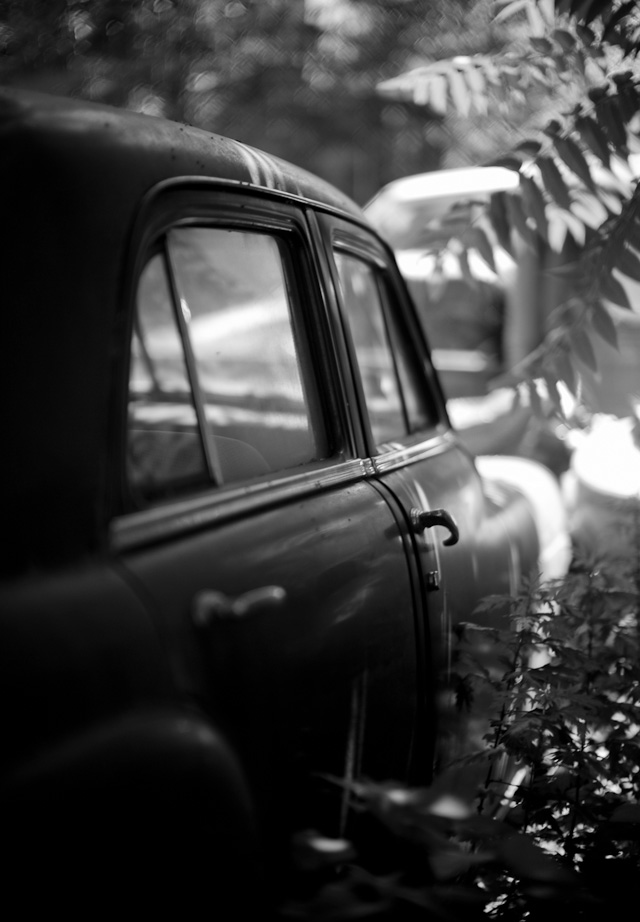
Brooklyn long term organic parking. Leica M240 with Leica 50mm Noctilux-M ASPH f/0.95
Olympus VF-2 viewfinder for the Leica m 240
Leica has gotten the Olympus VF-2 and rebranded it, and raised the price to somewhat the double. Which they have made no secret about. As far as I know it is not even Olympus but Epson that make the viewfinder for both Olympus and Leica. In any case, Leica did change the design of the shell to a (in my opinion) nicer design that aligns with the camera body and has a design-reference back to the Leica Visioflex. If one can justify the Leica or will go with the Olympus is up to one self. I bought the Leica as my first ... just because. I do realize this is the least resistent piece of the camera and probably one day will get smashed. It's not a Leica piece of stuff, it's not built to last and doesn't have much value over the Olympus except the logo and the slightly more pleasing look.
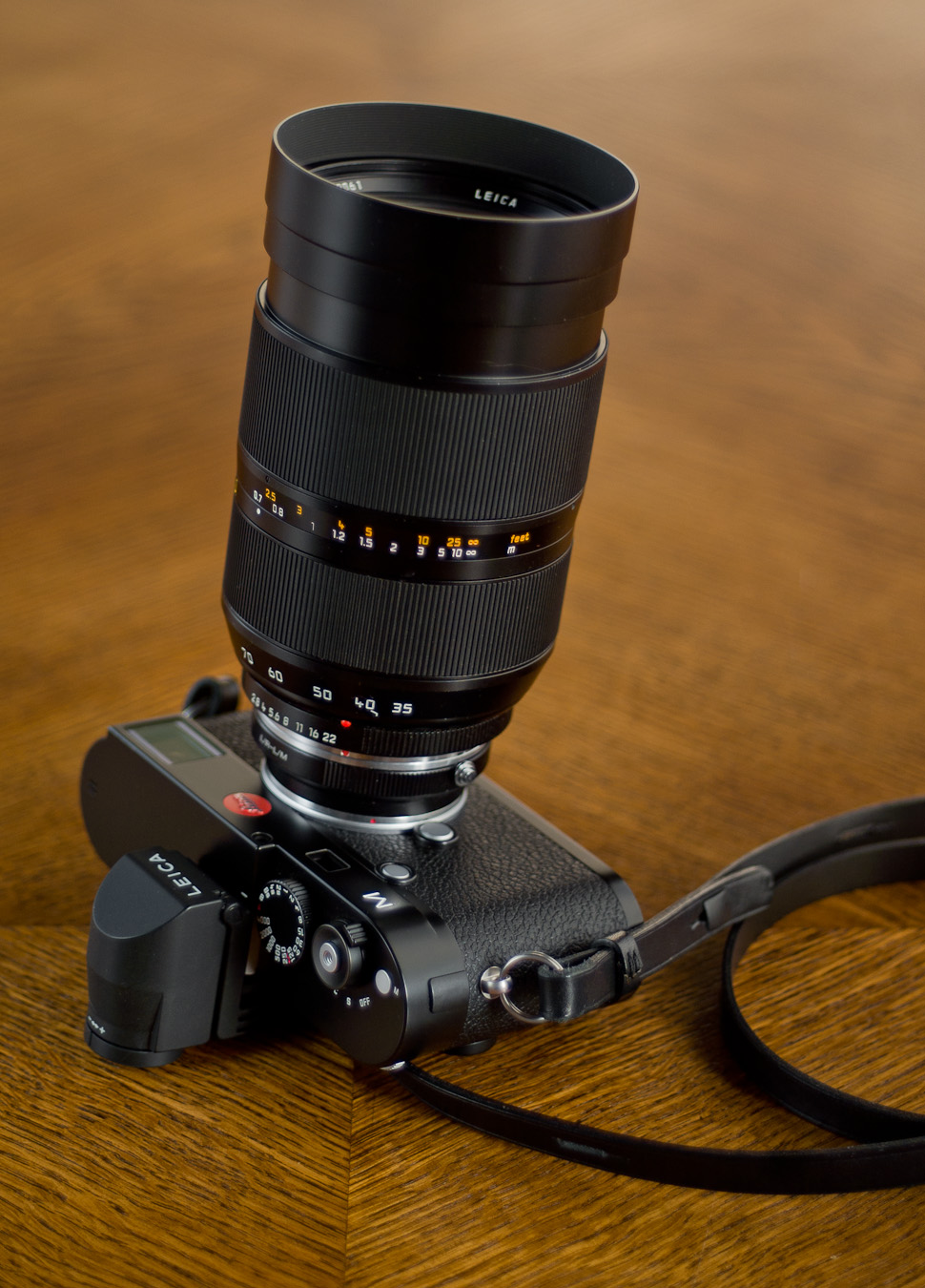
The rare Leica 35-70mm Vario-Elmarit-R ASPH f/2.8 Macro lens on the Leica M Type 240. It's a huge Leica M Type 240 kit but a fairly compact dSLR kit if you care to compare. One can discuss the relevance of using such a large lens on the Leica M 240, especially as the price is $10,000 - 14,000 these days. Collectors, Leica fans and RED users have discovered the qualities of this lens. Both the optical outstanding results, as well as a collectors item that is bound to go up in price no matter if it fits onto a camera or not.
Leica wanted to make the best zoom in the world, and they did. They started production 1996 but stopped producing the lens in 2002 after having made 200 of them. Apart from stellar glass it features the most advanced aperture construction in the Leica world (with the most aperture blades).
More about Leica R lenses on the Leica M 240 on Page 33 of this article.
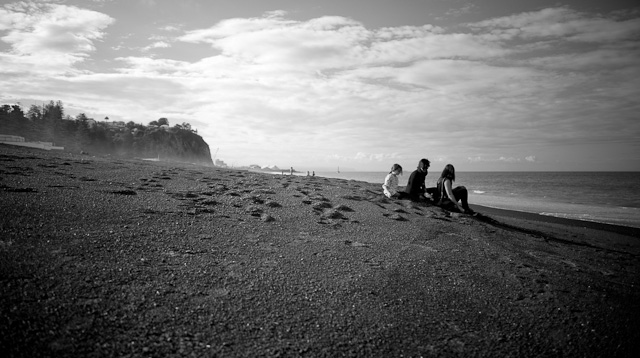
Black sand. New Zealand, April 2013. Leica M 240 with Leica M 240 with Leica 21mm Summilux-M ASPH f/1.4
Advertisement:

Wearing prescription glasses
and focusing with the Leica M Type 240
The analog viewfinder in any Leica rangefinder cameras is like viewing the subject at normal viewing distance. It is not as when you view via prisms on a matt screen few centimeters from the eye in a dSLR or SLR camera.
One of the advantages I had when I went from Leica R9 dSLR camersa to the Leica M system with the viewfindes was that I stopped having pain in my eye after a days photographing. The view through a Leica M is very natural and doesn't tire the eye.
As to prescription glasses, one should use whatever is nomal for being out and about. That means normal prescription glasses one would use for driving a car. Not screen or reading glasses for viewing at short distances.
 Leica 21mm Summilux-M ASPH f/1.4 sample photo" width="640" height="390"> Leica 21mm Summilux-M ASPH f/1.4 sample photo" width="640" height="390">
Manhattan, New York, June 2013. Leica M240 with Leica 21mm Summilux-M ASPH f/1.4
Problems with focusing
I meet people from time to time who can't focus a Leica M or who feel they have problems with it. Some times this will result that people buy additional glass such as the original Leica diopter mounted on the viewfinder. This works like glasses, so basically if you normally wear glasses, you take them off and have a diopter mounted in front of the viewfinder.
Others add a Leica 1.25X or 1.4X magnifier on the viewfinder so as to enlarge the viewfinder - to be closer to the image.
I find those add-ons unnecessary for me. The tendency is that people try these, and then find out it works better without.
One reason for problems with focusing can simply be bad prescription glasses. They are measured wrong or made wrong. Also, if one have glasses with three fields in them, one small center field will be for long distance viewing. If that field does not match the viewfinder (because it is in the 'wrong' place of the glass or the glasses are hanging down you nose), it doesn't work. If you have to lift your head or point your head down to drive a car so as to see the road clearly, your glasses are not right and won't work for a rangefinder.
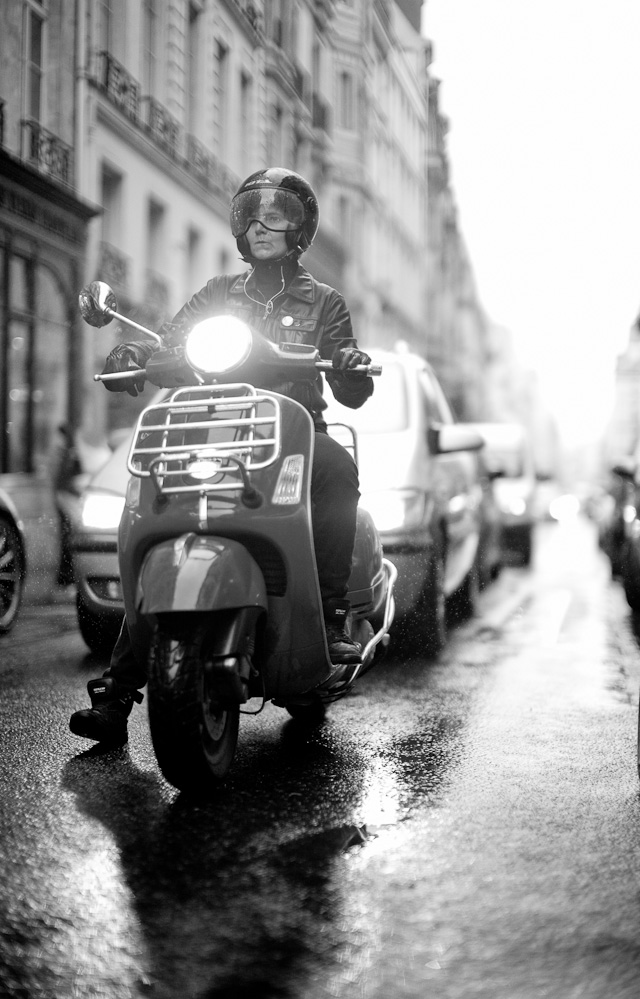
Paris, April 2013. Leica M Type 240 with Leica 50mm Noctilux-M ASPH f/0.95.
I'm mentioning this as I see so many that try so many things to get it right, and mostly they return to the naked viewfinder as the best solution. Because it is.
It is also important to realize that often when someone talk about how difficult it is for them to focus, either their camera is actually out of adjustment (and needs adjustment at Leica Customer Service), or they are so uncertain about focusing that they can't decide. If one can't make a decision about when the focus is there, that alone is a reason it fails. There are no focus indications in the Leica saying when it is in focus; you have to decide for your sefl based on what you see. If you can't make that desicision, that is your focusing problem.
Also, often when we have focus, the subject or the camera moves. And that is another reason for not having 100% focus.
Ther are many reasons and one should not take the subject of focus that serious. Even auto focus doesn't always get it right, and even photographers who have shot a lot on Leica M and have done it for years don't have a 100% hitrate. Far from, actually.
All in all, don't make it complicated. Focus and shoot, refocus and shoot. That way some of your photos will be in focus, and it's the ones in focus that are interstesting, not now large a percentage is out of focus.
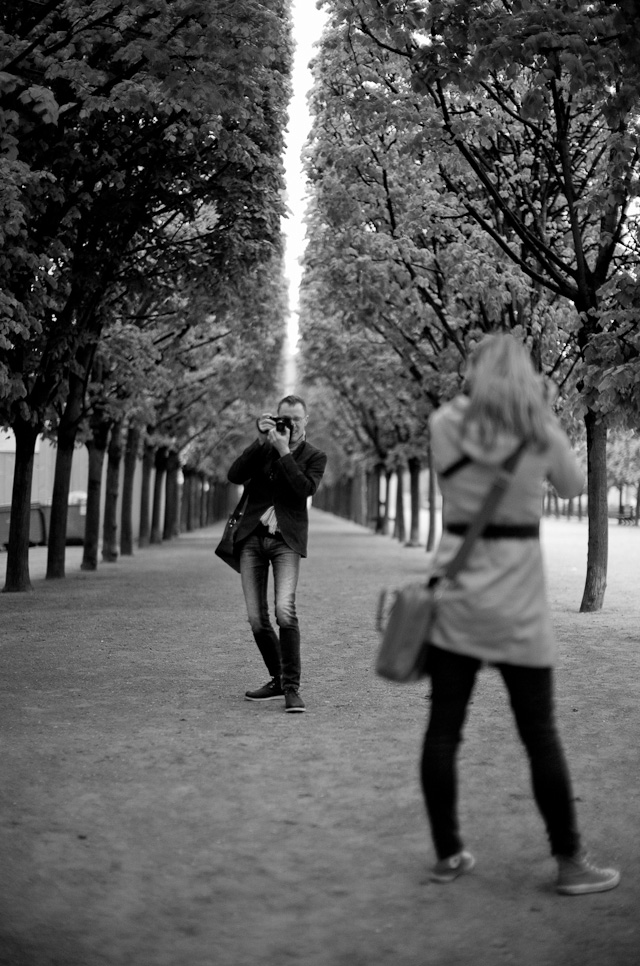
The shootout. Matthias Frei and Lisa Kutzelnig in Paris, April 2013. Leica M 240 with Leica 50mm Noctilux-M ASPH f/0.95
Framelines and wearing glasses
If you wear glasses you can somewhat see the 50mm frame lines inside the analog viewfinder. The viewfinder it self is almost 24mm viewing field. Using a 35mm lens is not a problem as you get used to moving about so you see the image. In the same manner that you don't see everything in the rear view mirror on the car, so you move your head. You don't think about it, you just move your eye so you see what is in the frame and what is not.
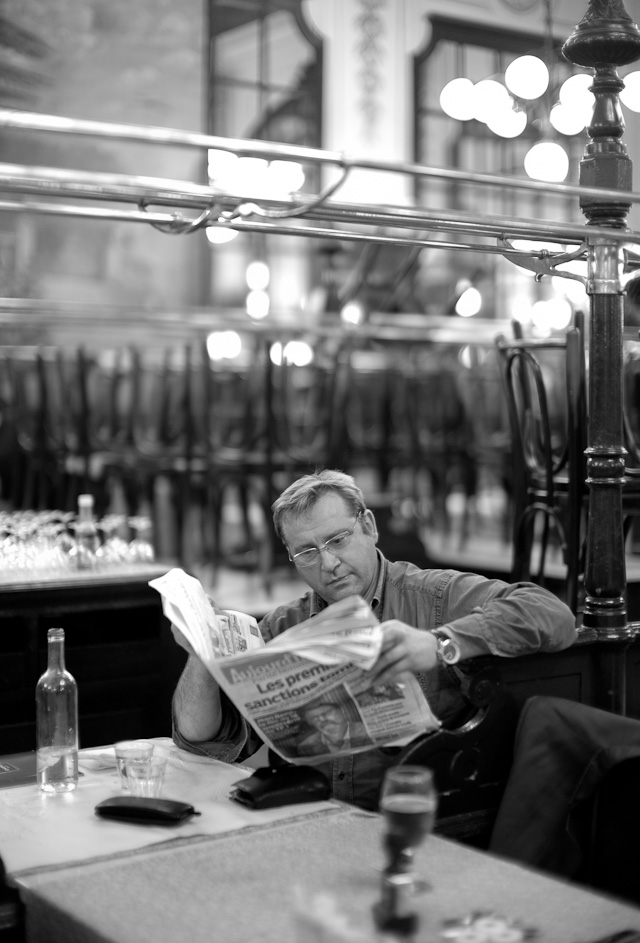
Paris, April 2013. Leica M 240 with Leica 50mm Noctilux-M ASPH f/0.95
Keep the manual handy on iPad and iPhone
The hallmark of Leica Camera AG - "unintelligible manuals"
I don't have much good to say about the Leica M 240 manual provided by Leica Camera AG. Traditionally German translated into English can be quite enteraining. I have a collection of funny signs from German hotels and other places of helpless translations. Even LFI is quite badly translated. Anyone who has tried to translate German to English know how troublesome German can be.
Unfortunately the manual is not just poorly translated into other languages but must make a similar helpless impression in all languages. But the manual is good to have as a reference for certain things.
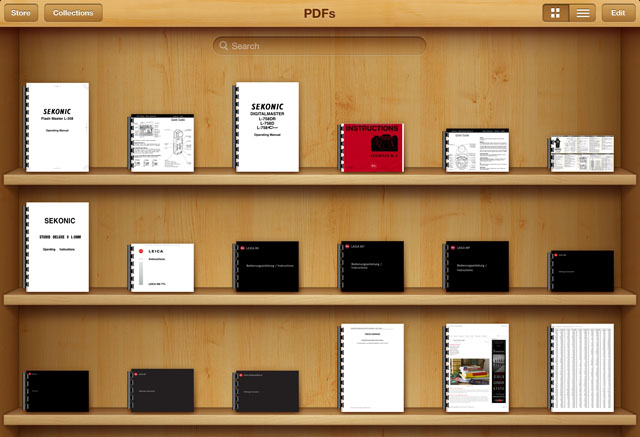
I have my manuals for lightmeters, Leicaflex cameras, Leica MP, Leica M7, Leica R9 and so on on my iPad for handy reference whenever I need it (which is often when there is some small detail I don't remember how to do). An advice hereby given.
Download my English-only manual here
You can download my edited Leica M Type 240 manual here (7.5 MB). I have removed the German pages so only English search results come up when you search the PDF document. (And I have put the parts of the camera description next to the illustration of the camera).
If you download the manual on your computer and e-mail it to yourself, you can open the mail on your iPad or iPhone and then hold down your finger on the PDF symbol > and from there define that you want the manual to open in iBooks.
You can also go a simpler way and open iTunes on your computer and drag and drop the PDF into iTunes and it will be in iBook when you syncronize next time.
Battery and charger
The battery for the Leica M 240 is quite large and will usually last for a full day. It is made that large so as to support video shooting as well as Live View that takes some more energy.
The CMOS sensor in the camera uses less energy than a CCD, so when shooting, using the analog viewfinder and not Live view and video, the battery time is quite impressive.
I recommend two batteries as that is easy to manage. You start off the day with two charged batteries and if/when one is low, you drop in the next. During the evening and night you charge first one, then the next (a couple of hours charging and it is on 100% power again).
I also recommend two chargers in case you forget one in a hotel room or similar. When I travel I always have one battery charger and possible power plugs (for the airports, airplanes and countries I come by) in my photo bag, and another charger in the checked in luggage. Thus, in case the checked in luggage is delayed, I have a charger with me together with the camera.
I try always to spread my chargers in different locations/bags as I have actually (I regret to disclose) forgotten chargers both home and in hotels by having them all in the same place, arriving at a new destination without any chargers.
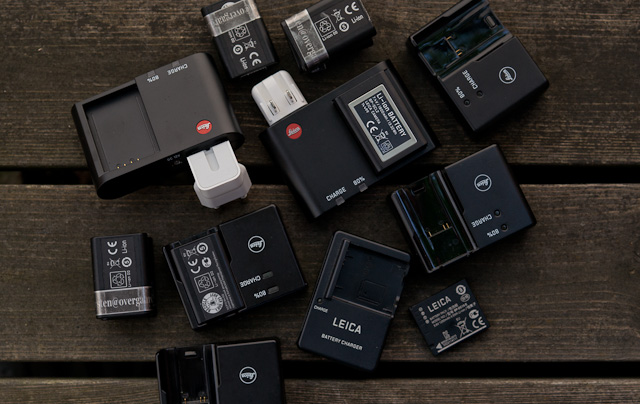
My collection of batteries and chargers for the Leica M 240, Leica M9, Leica M Monochrom and Leica D-Lux 6. Note the Apple Travel Kit plugs. Apple Store sells a package where one get four different plugs and thus have converters for most countries in the world. Fits Apple products, and Leica chargers.
Low on battery
The Leica M 240 does not show battery level by it self. If you look through the viewfinder or on the review screen on the back and press the INFO button (to the right of the display), the display will give a percentage of how much battery is left.
When the camera is down to 20% battery power the display will show that you are down to 20% as a single alert.
Next alert will be that you are "low on battery, switch off the camera".
Lightroom with the Leica M 240
Adobe Lightroom comes with most Leica cameras, also the Leica M Type 240. From June 15, 2013 and onwards, if one activate the licence code in the Leica M 240 package, one will get Lightroom 5. If you activate your code at a later point you will get the Lightroom 6 version or whichever version of Lightroom is the current.
Leica M 240 prices ... a challenge for Leica Camera AG
As a worldwide luxury brand the Leica M 240 should be the same price worldwide. But this is not the case. When the demand is high and delivery less than demand, as it is the case for most Leica products, it seems to attract black market middlemen and premium price mentality.
e-Bay prices are usually $1,500 above retail price. Premium prices seem to fare best amongst US buyers and Asian buyers. In Europe paying premium is not normal in stores or from person to person.
Singapore $8,678 (minus 5.5% refundable GST/VAT) but often sold with a lens only (if you don't buy a lens with the camera you will be sent back in the waiting list).
Hong Kong $9,750 (no VAT in HK)
USA $6,950 (plus local non-refundable sales TAX/VAT, in New York 4% making the price $7,228)
Bangkok $8,780
Denmark $8,750 (minus 13-19% refundable VAT of reatil price; net price shipped is $7,097)
Germany $8,300 (minus 9-16% refundable VAT of retail price; net price shipped is $6,975)

Madison Square Park, New York. June 2013. Leica M 240 with Leica 50mm Noctilux-M ASPH f/0.95
Possible Leica M 240 errors and how to fix them
Leica M Type 240 camera freeze
The Leica M will occasionally freeze both in still mode and video mode. The handling it to turn off the camrea and turn it on again. Some times, taking out the battery and inserting it again is the proper handling.
In video mode the camera appear dead, as if the battery is dead. Simply turn it off, take out the battery and insert it again, then start the camera and continue.
In still mode the red light on the back will usually stay on and the camera won't shoot.. You can even feel that the release button is stiff and won't respond. Take out the battery and insert it again, then the camera will work normal again. Some times you will loose the last image(s) in a continious burst because the camera simply froze during writing to the SD-card.
Leica Camera AG is aware about this problem and is working on finding the possible reason and will fix it with a firmware update.
It is not something that will happen that often. I have had the camea freeze 5 times in still mode and once in video mode in the first month. Somehow less in the next two months.
It is my impression that it is solely the buffer and not related to the EVF-2 digital viewfinder or the 10x focus aid. The error appear to happen when you have shot a series of images and then after a short break shoot one more series. The second series is likely not recorded on the card as the camera freezes trying to write them to the card.
But as said, it will be history soon. So enjoy it as it lasts.

Bryant Park, New York. June 2013. Leica M 240 with Leica 50mm Noctilux-M ASPH f/0.95
EVF-2 freeze
Some times the EVF-2 image will freeze, either because the camera freezes, or simply just the EVF-2. This will result in a half image in the viewfinder, or the EVF-2 seems locked in 10X mode. In any case, the image is staying the same and not moving. The solution is to wait a little, or even better; turn the camera off and on again.
One possible reason to this error I have noticed is when th EVF-2 moves slightly back and thus doesn't have proper contact inside the camera.
SD-card errors
I haven't heard of any errors on SD-cards related to the Leica M 240. SD-cards can have errors, and in that case SanDisk or other manufacturer of the SD-card will replace them.
 |
NEW VERSION 11.3 |
 |
| |
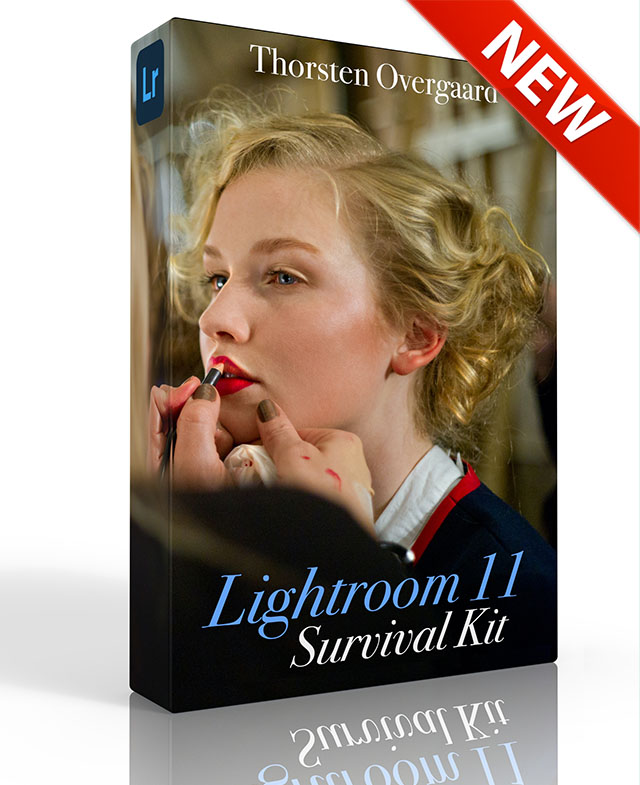 |
|
| |
|
| |
|
|
|
|
| |
|
| |
|
|
| |
Buy Now. Instant delivery.
New Version 11.3
ONLY $698.00

Now includes
4+ hours of
video tutorials.
100% satisfaction
or 100% refund.
More info.
|
|
| |
#2130-1121-3 |
|
| |
|
|
| |
Update to Version 11.3
Apply
code "UPDATE113" on checkout to get this complete version 11.3 update.
$298.00

Updates all previous Surival Kit versions since 2009. |
|
| |
|
|
Buy the complete new
Lightroom Survival Kit 11.3
The Legendary Tutorial for Photographers
Brand-new JUNE 2022-version.
Now with brand-new 4+ hours of video tutorials.
New sections on compostition and storytelling.
How to edit color photos.
How to edit black & white photos.
How to do keywords logical and easy.
The most successful photo editing kit ever
Photographer Thorsten Overgaard first released the Lightroom Survival Kit in 2009 and have honed it with new and fresh updates. This Version 11 is the most radical updated and renewed version ever, four years in the making.
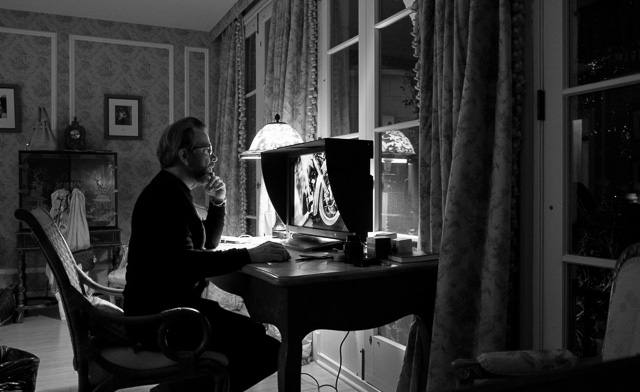
Professional workflow experience made simple, logical and easy to use.
Master editor makes it simple to understand
The Survival Kit is unique and one-of-a-kind being made for photographers for photographers. When someone understands their subject, they can explain it so it is easy to understand. The hallmark of Thorsten Overgaard is to make expert knowledge shown and told in a way so anyone can apply it.
Hands-on advice that works
With a 450 pages workbook and 4+ hours of video, every element of digital photography is touched on, in handy chapters and pre-flight checklists. Editing of color vs black and white photos, keywording, cropping of images, fine-tuning of tones, color balance and color control, export of originals, printing, archiving and backup, and much more.
Comes with the Overgaard Leica Presets (Value $48)
The Lightroom Survival Kit comes with Thorsten Overgaard's special-made Lightroom Presets for all digital cameras and for Leica digital cameras.
Understand all from camera to the final print
Chapters in this version goes over the background for High Dynamic Range (HDR), digital raw files and how to set up a professional photography workflow, from calibrating the screen to editing in Lightroom, and to making a final print. And more ...
10+ years experience in one package
No need to spend years figuring out the smartest way to do things when you can tap into the best way of doing things right here. The workflow of Thorsten Overgaard as been refined through years of field work with more than a thousand workshop attendees.
This method of workflow now used by thousands
The Survival Kit has been taught to thousands in workshops and in this Survival Kit. What does it do? It make you enjoy taking and making photos, and it increases your production considerabely. Most important of all, it'll give you back ownership of your files (which you will understand why is so important, once you have bought the Survival Kit and started applying its methods).
| |
|
|
| |
"Thorsten's methodology is perhaps not what hardware-, software- and cloud-companies want us to do, but as a former IT engineer I can only acknowledge his views about preserving our digital heritage. This workflow explained is for me the best I have ever seen".
★★★★★ |
|
| |
|
|
Video tutorials, image files, presets, checklists, definitions, tutorials of Lightroom, that boils down years of experience to a workflow you can implement in less than one day.
Start working in minutes. |
|
|
| |
|
| |
|
| |
|
| |
|
| |
|
| |
|
|
|
|
 |
|
 |
AUTO-ISO doesn't work properly
Auto ISO only works in Aperture Priority, meaning that the shutter speed wheel on top of the camera is on A (also known as M Mode). If you turn the shutter speed while in AUTO-ISO, the camera will use the ISO set for the last image (but the menu choice will still say AUTO-ISO).
Leica Camera AG have said about this (June 2013), that they "will make it adjustable as an option for the user, which means you can choose in the menu if Auto ISO is available in M Mode or not. This will be implemented in a future firmware update."

Madison Square Park, New York. June 2013. Leica M 240 with Leica 50mm Noctilux-M ASPH f/0.95
Not reading lens code
My lens mount allows the lenses to travel a very tiny little bit. Enough so that the eye on the bayonet that is supposed to read the 6-bit code on the lens cannot always read the code so the camera believes the lens is "Uncoded". This will happen in very rare instances (on only one of my lenses). Leica Customer Service can fix this.
Sign up for the all new course today:

"There is no lens attached" using lens adaptor or other lenses on the Leica M Type 240
Some lensees and lens adaptors are black on the bayonet that is in front of the 6-bit code reader and then it reads for the camera as if there is no lens on the camera. Hence you can mount the lens (adaptor) but the Live View that you need to use other than Leica M lenses won't activate. It's to protect the sensor as the camera doesn't see the lens.
To remedy this, paint the lens - or put a white or silver label - on the bayonet of the lens (adaptor) where the 6-bit lens code reader sits (not on the camera, on the lens!)
Focus aid not always activated automatically ... this is why
| Focusing: |
 |
 |
| It's the chrome metal wheel in top, inside the bayonet, that makes focusing on a Leica M possible. It is also the movement of this wheel that activates the Focus Aid. |
 |
It is magic to experience that when you turn the focus ring, the camera automatically turn on the 10X focus aid in the viewfinder or on the preview screen on the back. It is less magic to experience when this does not happen even you set it to Automatic in the menu.
The Focus Aid is activated by the physical movement when a Leica M lens pushes the chrome wheel inside the bayonet (which is part of the analog viewfinder's focising mechanism).
Hence, when you use non-Leica and Leica R lenses, the Focus Aid does not work. You will have to press the Focus Aid button on the front of the camera.
Battery drain
Normally the Leica M240 is set to power-off after two minutes and will power off. One should be aware that if the camera is on (set to Single or Continious release) the power if off after two minutes. But if the camera is in a bag or similar condition where the shuttter release button is pressed down again and again, or all the time, this will drain the battery as the camera is on.
The camera does not focus properly (back focus or front focus)
The rangefinder mechanism can go in and out of focus. It is usually the camera though lenses also some times need adjustment.
The way to check if the camera is focusing wrong, is to go outside and find a point more than 50-100 meters away and then focus on infinity. If the focus goes beyond the horizon or can't go all the way to the horizon, the focus is off.
Most likely it is the camera that need adjustment, and that is done by Leica Customer Service or someone who knows how to do it. It involves the adjustment three places inside the camrea.

Restaurant Tartine, 235 W 11th Street, New York, June 2013. Leica M 240 with Leica 50mm Noctilux-M ASPH f/0.95
Leica SF58-D flash
There seems to be a communication issue between the flash and the camera in Firmware 1.1.0.2 so that the lenses do not trigger the zoom function in the flash properly. A 35mm lens comes up as 75mm, 75mm as 105 mm and so forth. This will be fixed in future firmware.
Camera strap lugs may fall off (ONLY on cameras shipped prior to April 5, 2013)
| |
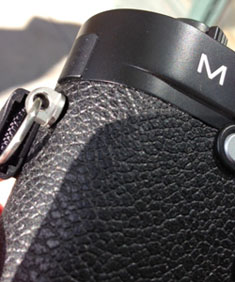 |
| |
At least one camera strap lug fell off. This is the image of it. |
On April 24, almost two months after the first Leica M Type 240 started shipping, Leica Camera AG sent out an e-mail to the customers who received their camera before April 5, asking them to ship it back for a check of the strap lugs.
To my knowledge there has been one case of lugs falling off. The reason is that when the screws are tightened (from inside the camera body onto the camera strap lugs), a type of glue in the top of the screw is activated and glues the screw so it stays in place.
Some of the screws Leica Camera AG used had faults, and that is why Leica Camera AG had to make a recall on all the cameras that could potentially have been affected, when they discovered the error.
The letter from Leica Camera AG said:
"Dear Leica M Customer,
We are aware of the fact that a few of the Leica M (Typ 240) cameras shipped before April 5, 2013, experienced loose carrying strap eyelets. We identified that this was caused by an assembly fault that occurred in the Leica M (Typ 240) production line. Products potentially affected only concern Leica M (Typ 240) cameras shipped prior to April 5, 2013. After identifying what happened, we fixed the production issue immediately. Rest assured that the issue has been completely resolved and corrected. We are deeply sorry that this occurred.
Having crosschecked the camera’s serial number, we regret to inform you that your camera 4444550 is affected."
The mail from Leica Camera AG also stated that they would pay for all costs of shipping the camera back and forth. In their FAQ Leica Camera AG also guaranteed they would take full responsibility for all problems due to the error:
"What happens if my Leica M Typ 240 is damaged due to loose eyelets? Answer: If your camera and/or lens were damaged due to this fault we will replace them free of charge."

DUMBO under Brooklyn Bridge, New York, June 2013. Leica M240 with Leica 21mm Summilux-M ASPH f/1.4.
| |
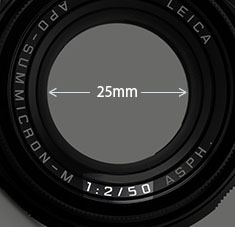 |
| |
1:2/50 the description says.
But what does it mean? |
| |
|
1: = Basically means 1 divided with. On the lens to the right, it means that the diameter of the hole throught he lens is 25mm.
We would normall call it
a 50mm f/2.0 lens. The writing of 1:2/50 is a tradition from the 1800's of specifying a lens, which reveals quite a bit about the construction:
Focal length 50mm simply means that the distance from center of focus inside the lens to the focusing plane (the sensor or film) is 50mm, and the aperture of f/2 or 1:2 means that the diameter of the hole the light comes throught is 25mm (50mm divided with 2 = 25mm).
In traditional lens design, one could usually tell from looking at the length of a lens if it was a 400mm, 100mm or 35mm. Newer designs with mirrors (in tele lenses) and more corrections (in wide lenses) can make the size of the lenses shorter or longer, but the distance from center of focus to sensor in a modern 50mm lens will still be 50mm for a 50mm and 400mm for a 400mm, and so on.
See Focal length and Aperture further down for more.
35mm
a) 35mm lens is a lens that has a viewing angle of view is 63°vertically, 54° horizontally and 38° vertically within a 35mm film frame or "full-frame" 24x36mm digital format. See Focal length further down.
b) 35mm focal length: the distance from center of focus inside the lens to the focusing plane (the sensor or film) is 35mm.
| |
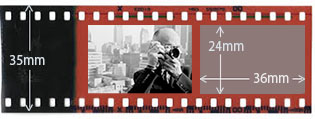 |
| |
35mm film format (also known as full-frame) |
| |
|
c) 35mm film format (also known as full-frame in digital sensors) was a standard film format that came about in 1892 where the width of the film roll was 35mm, and it's been the most used format ever since. Only a format of 24 x 36mm is used for the photo on the film roll.
35mm film format was first used in 1892 by William Dickson and Thomas Edison for moving pictures with frames of 24 x 18mm, using film supplied by George Eastman (Kodak), and this became the international standard for motion picture negative film in 1909. Later other motion picture formats came about, such as Academy Ratio (22 x 16 mm), Widescreen (21.95 x 18.6 mm), Super 35 (24.89 x 18.66 mm) and Techiscope (22 x 9.47 mm).
The inventor of the Leica camera, Oskar Barnack, built his prototype Ur-Leica in 1913 as a device to test film stock and\ motion picture lenses and had it patented. Putting 35mm film format into a small camera gave him the idea "small negative, large print" and he decided to increase the size of each frame on the 35mm film to 24x36mm (for more detail and sharpness), and then invented an enlarger to make large prints from the small negative. The length of a film, 36 pictures, is said to have become the standard because that was how far Oskar Barnack could stretch his arms (when cutting film from larger rolls to put them into film rolls for the Leica camera).
d) 35mm equivalent is often given as a standard when talking about lenses in small compact-cameras or large format cameras with other sensor/film format than the 24 x 36mm frame. Example: A camera with a 12 x 18 mm sensor has a 14mm lens on it, and even the lens is actually a 14mm, it is specified as a 28mm lens because the viewing angle that ends up on the sensor is equivalent to a 28mm lens on a 35mm of full-frame camera.
| |
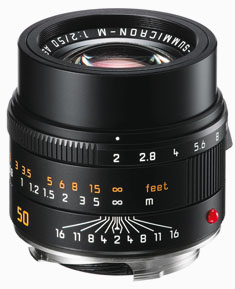 |
| |
The Leica 50mm APO-Summicron-M
ASPH f/2.0 lens |
| |
|
50mm
a) 50mm lens is a lens that has a viewing angle of view is 47° vertically, 40° horizontally and 27° vertically within a 35mm film frame.
b) 50mm means there is 50mm from the center of focus inside the lens to the focal plane (sensor or film).
c) 50mm lens is often compared to the human eye. Not because of viewing angle (how wide it sees) but because of size ratio (how it sees). The 50mm lens is the lens that comes closest to the size that the human eye see things. Whereas the human eye has a much wider angle of view [120-200°] than the 50mm lens [47°].
AF = Auto Focus. The idea is that the camera does the focusing itself (the word auto comes from Greek "self").
Aperture = The same function as the iris and pupil has in the eye. The pupil in the eye is the dark circular opening in the center of the iris of the eye, varying in size to regulate the amount of light reaching the retina (the sensor area inside the eye).
Aperture on a camera is the f/ stop on the camera that regulates how much light passes through the lens by increasing or decreasing the hole through the lens. On a f/2.0 lens the lens is fully open" at f/2.0. At f/2.8 the aperture inside the lens make the hole through the lens smaller so only half the amount of light at f/2.0 passes through. For each f/-stop (4.0 - 5.6 - 8.0 - 11 - 16) you halve the light. The aperture of the lens is basically the focal length divided with the f/-stop = size of the hole (50mm divided with f/2.0 = the hole is 25 mm in diameter).
Besides regulating the amount of light (so as to match the correct exposure), the aperture also affects the dept of field: , which is how deep the sharpness is. To get the sough-after photos with narrow depth of field where the background is blurry, the lens has to be wide open at f/2.0 or so. Stopping the lens down to f/8 or f/16 will result on more depth of field, meaning the background will start becoming in focus. To maintain narrow depth of field, one can use the ISO sensitivity and/or the shutter speed to match the correct exposure (as aperture is only one of three ways to control the exposure; the correct amount of light).
ORIGIN: Late Middle English : from Latin apertura, from apert- ‘opened,’ from aperire ‘to open’.
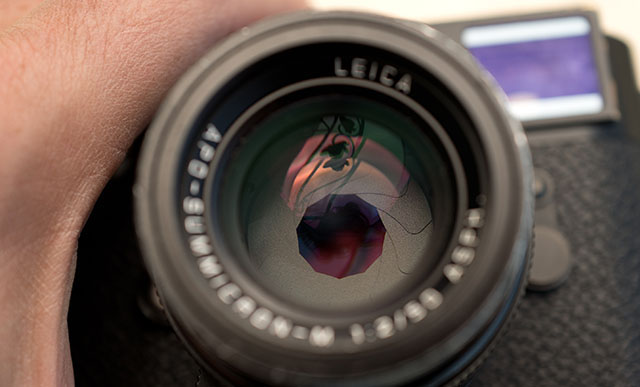
The aperture blades inside the consist of a number of blades that - as the aperture ring on the lens is rotated - narrow into a smaller and smaller hole. © Thorsten Overgaard.
| |
 |
| |
The camera in Aperture Priority Mode |
| |
|
Aperture Priority Mode = When the shutter speed dial on top of a Leica M camera is set to A, it is short for “Aperture Priority” and allows the user to set a specific aperture value (f-number) while the camera selects a shutter speed to match it that will result in proper exposure based on the lighting conditions as measured by the camera's light meter. In other words, you set the aperture as priority (f/1.4 for example), and the camera calculates a shutter speed (1/250 of a second) that matches that. If you change the aperture to f/2.0 by changing the aperture ring on the lens, the camera will re-calculate the speed to 1/125 so as to get the same amount of light to hit the sensor (f/2.0 is half the light through the lens as f/1.4 and 1/125 if twice the amount of light on the sensor as 1/250).
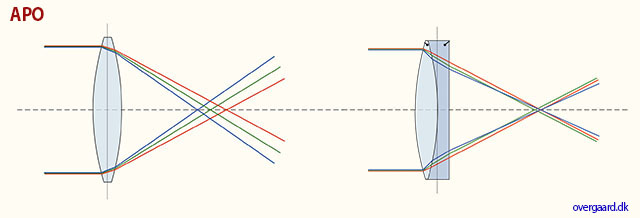
APO corrected basically means that the red, green and blue has been corrected to meet more precisely in the same spot. Clarity of colors and definition of details would be the result.
APO = in lens terminology stands for "apochromatically corrected". In most lenses, optical design concentrates the focus of blue light and green light into a single plane, but red light falls slightly into another plane of focus. In APO lenses, the design and expense has been put in to making red light focus on the same plane as blue and green. Under a microscope you would see that all light subject is now in focus, creating a sharper image overall. Many manufacturers offer APO designs, but in most of these only the very center of the lens is APO corrected. Leica prides itself on making most of the frame APO corrected.
APo-correction has traditionally been used for long tele lenses (and periscopes), but in recent years APO-correction has been applied to 50mm and wide angle lenses as well. One will notice that the colors are really bright and alive, almost more real than to the eye, in lenses like the Leica 90mm APO-Summicron-M ASPH f/2.0 and 50mm APO-Summicron-M ASPH f/2.0.
Apochromat; ORIGIN early 20th century, made of the two words; apo (Greek origin, away from) and chromatic (Latin origin, meaing relating to color).
| |
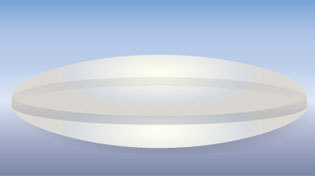
spherical (ball) |
| |

a-spherical (non-ball) |
| |
|
ASPH = (Aspherical lens) stands for "aspheric design".
Most lenses have a spherical design - that is, the radius
of curvature is constant. These are easy to manufacture by
grinding while "spinning" the glass. This design
however restricts the number of optical corrections that can
be made to the design to render the most realistic image possible.
ASPH lenses (a-spherical, meaning non-spherical), however, involve usually 1 element that does
*not* have a constant radius of curvature. These elements
can be made by 1) expensive manual grinding, 2) molded plastic,
or 3) Leica's patented "press" process, where the element
is pressed into an aspherical ("non-spherical")
shape. This design allows Leica to introduce corrections
into compact lens designs that weren't possible before. Practically,
the lens performs "better" (up to interpretation)
due to increased correction of the image, in a package not
significantly bigger than the spherical version.
There is another Aspherical lens manufacture technique: an uneven coating layer is applied to a spherical lens. The coating is thicker on the edges (or on the center, depending). Canon "Lens Work II" calls these "simulated" aspherical lenses. Simulated and Glass-Molded (GMo) asphericals show up in non-L Canon lenses, while the L lenses have actual ground aspheric elements.
A- means non, or without. From Latin, ex.
Sphere: ORIGIN Middle English : from Old French espere, from late Latin sphera, earlier sphaera, from Greek sphaira "ball".
| |
|
|
 |
| Normal spheric lens (grinded) |
|
ASPH (note the shape of the glass as result of pressing rather than grinding) |
Auto- means “self”. The idea is that when a camera has auto-(something), it does that (something) by itself.
Banding = Noise in digital images. Horizontal lines in a horizontal picture (if the camera is in portrait mode/vertical, the lines will obviously be vertical). It's simply noise; the result of uncontrolled algorithms working overtime with an image the sensor really can't see because it's very dark. (If your image has vertical lines in it, it is more likely that the sensor needs remapping).
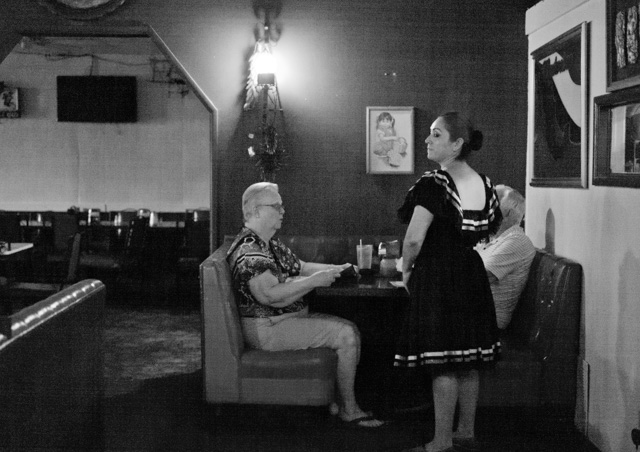
This image at 6400 ISO, underexposed and then brought up to correct exposure in Lightroom, displays banding: Horizontal lines in the image. Leica M-D 262 with Leica 50mm APO-Summicron-M ASPH f/2.0.
Base ISO = The ISO the digital sensor was born with. Even a digital sensor goes from say 50 ISO to 25,000 ISO, it only has one base ISO. Any other setting is an algorithm that figures out how the image whould look if there was 64 times more light, or half the light, etc.
When you go down from Base ISO (for example 200 to 100 ISO), you can expect a
decrease in quality. When you go up, the decrease is much less. For some sensors, you loose 2-3 stops by going down 1 step in ISO, but can go 8 steps up and only loose 1 stop in dynamic range. Basically, your ISO range should be from Base ISO and as far up as you can, before you see visible decrease in quality (mostly 3200 ISO - 6400 ISO).
Base ISO for Leica M9 is 160 ISO, for Leica M240 it is 200 ISO. For Leica M10 it is around 160 ISO. For Leica M Monochrom it is 320 ISO. For Leica Q and Leica Q2 it is around 100 ISO. For Panasonic Lumix S it is 200 ISO. For most Canon cameras the base ISO is around 100, for most Nikon cameras it is around 200 ISO.
Bokeh = The visual quality of the out-of-focus areas of a photographic image, especially as rendered by a particular lens: It's a matter of taste and usually photographers discuss a 'nice' or 'pleasant' bokeh (the out-of-focus area is always unsharp, which is why the quality discussed is if one likes the way it renders or not by a particular lens). The closer you get to something, the 'more' bokeh' you get (in that the focus becomes less for the background and foreground at close distances than at long distances). ORIGIN from Japanese 'bo-ke' which mean 'fuzzines' or 'blur.'.
 Bokeh: The visual quality of the out-of-focus areas of a photographic image. Photo at Bar del Fico in Rome. Leica TL2 with Leica 35mm Summilux-TL ASPH f/1.4. © Thorsten Overgaard. Bokeh: The visual quality of the out-of-focus areas of a photographic image. Photo at Bar del Fico in Rome. Leica TL2 with Leica 35mm Summilux-TL ASPH f/1.4. © Thorsten Overgaard.
C = Continuous shooting. When the ring by the Shutter Release on top of the camera (or in the menu of digital cameras that doesn't have such a feature on the outide of the camera) is moved from OFF to C, the camera takes series of images as long as the shutter release is pressed down. In some cameras the speed of continious shooting can be adjusted.

Camera comes from Chambre, mostly in relation to Spanish soldiers’ rooms. Obscura means 'dark', so a dark room is basically the derivation for the word camera.
Camera - is today’s short name for Camera Obscura (meaning “a dark room”). Camera means Chambre and was used only as a Latin or alien word, actually only for Spanish soldiers’ rooms, until popularized in connection with photography in 1727: “Camera Obscura”. In 1793 the slang term “camera” was used by Sterne Tr. Shandy: “Will make drawings of you in the camera” and by Foster (1878), “The eye is a camera”. Camera Obscura was described by Iraqi scientist Ibn-al-Haytham in his book, “Book of Optics” (1021) and by Leonardo da Vinci in 1500; popularized and made widely known in 1589 by Baptista Porta when he mentioned the principle in his book “Natural Magic”. Johannes Kepler mentions Camera Obscura in 1604.
Camera = chambre (room), Obscura = dark (or cover).
| |
|
|
| |
Why is it called a "camera"..?
The word Camera is today's short name for Camera Obscura (which originally means “a dark room”).
Origin of the word Obscura means "dark" or "covered", and the word Camera means Chambre and was used originally only as a Latin or alien word, actually only for Spanish soldiers' rooms, until popularized in connection with photography in 1727: “Camera Obscura”.
In 1793 the slang term “camera” was used by Sterne Tr. Shandy: “Will make drawings of you in the camera” and by Foster (1878), “The eye is a camera”.

Ibn-al-Haytham mentioned Camera Obscura in his "Book of Optics" in 1021.
The concept of Camera Obscura was described by Iraqi scientist Ibn-al-Haytham in his book, “Book of Optics” (1021) and by Leonardo da Vinci in 1500; popularized and made widely known in 1589 by Baptista Porta when he mentioned the principle in his book “Natural Magic”. Johannes Kepler mentions Camera Obscura in 1604.
Camera = chambre (room), Obscura = dark (or cover). |
|
| |
|
|
CCD sensor (as used in Leica M8, M9, Leica S) = (Charged Coupling Devices) - The first digital cameras used CCD to turn images from analog light signals into digital pixels. They're made through a special manufacturing process that allows the conversion to take place in the chip without distortion. This creates high quality sensors that produce excellent images. But, because they require special manufacturing, they are more expensive than their newer CMOS counter parts.
CLA
An acronym for "(C)lean, (L)ubricate & (A)djust", whereby the item is merely re-lubricated, fine-adjusted and calibrated rather than repaired. "I just got my equipment back from CLA at Leica"
CMOS sensor (as used in Leica CL, Leica T/TL/TL2, Leica M10, Leica M 240, Leica M Monochrom Typ 246, Leica S Typ 007, Leica SL, Leica Q, Leica Q2, Leica M10, Leica X, Leica D-Lux, etc.) = (Complimentary Metal Oxide Semiconductor) chips use transistors at each pixel to move the charge through traditional wires. This offers flexibility because each pixel is treated individually. Traditional manufacturing processes are used to make CMOS. It's the same as creating microchips. Because they're easier to produce, CMOS sensors are cheaper than CCD sensors. CMOS allow Live View and use less energy than CCD.
Collapsible - Usually refers to a collapsible lens such as the Leica 50mm Elmarit-M f/2.8 Collapsible, or Leica 90mm Macro Elmar-M f4.0 Collapsible, etc. A collapsible lens is one that can collaps into a compact lens when not in use.

The Leica 50mm Elmar-M f/2.8 Collapsible on a Leica M10-P Safari. Here extruded for use; it can collapse into the camera so as to be more compact when not in use. © Thorsten Overgaard.
Contrast - The degree of difference between tones in a picture. Latin contra- ‘against’ + stare ‘stand.’
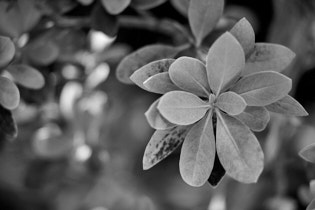 |
|
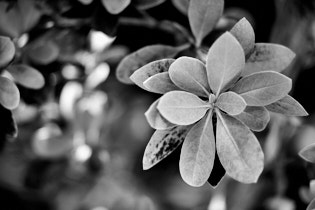 |
| Normal to low contrast |
|
High contrast |
| |
|
|
D-Lux (Digital Lux) = A series of compact digital cameras by Leica Camera AG developed with Panasonic since 2003. See my article "Compact Digital Leica Cameras" and my Leica D-Lux 7 review. Lux comes from Latin and means Light.
| |
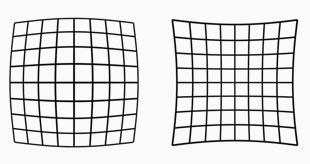 |
| |
Lens distortion looks like this. The lines are not straight. Our eye uses distortion correction. Lens designers can design lenses so they have very little distortion, or they can make less complicated lens designs and "fix" the distortion in software. |
| |
|
Distortion = In photo optics/lenses: When straight lines in a scene don't remain straight because of optical aberration.
Lens designers can correct for distortion to a degree so the whole image field is perfect corrected and all lines remain straight. In modern lens design many designs rely on Software Distortion Correction (SDC).
The eye adjusts for distortion so we always see vertical and horizontal lines straight when we look at things. Even when you get new prescription glasses (if you use such), you will often experience distortion in your new glasses. After a few days they eyes have adjusted for the glasses and the distortion you saw to begin with is now gone. Software Distortion Correction (SDC) is far behind what the human eye can perform of adjustments. (Also see my definition on Perspective for more on the eye and optics)
DNG = Digital Negative, an open standard developed by Adobe. It is a single file that contains the raw image data from the sensor of the camera as well as date, time, GPS, focal length, settings, etc.
The alternative is a RAW file + XMP file where the RAW file contains the image information and the XMP contains the rest of information about where, how and when the picture was taken, as well as editing data when the photo is edited in Lightroom or Capture One.
A Camera Raw profile (that is specific for that camera) in the computer helps the software program, for example Adobe Lightroom, to translate the RAW data into the image. Camera producers provide a Camera profile with their camera, and Adobe makes their own 'refined' Adobe Raw camera profile for all new cameras.
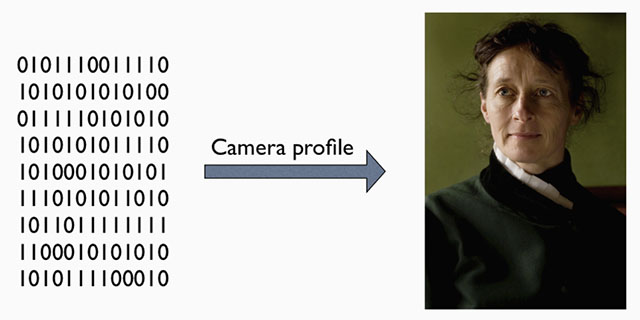
A raw file (or DNG) is simply the full recording of digital data (1's and 0's) from the sensor. In the computer, the sensor data is translated into the exact colors, via a camera profile.

Narrow Dept Of Field in use: The face is in focus, the hand in front is slightly out of focus, the background is much out of focus and blurry, reduced to an atmosphere. Leica 50mm Noctilux f/1.0 at f/1.0 and 2.5 meters distance to subject in focus. © Thorsten Overgaard.
 |
|
 |
| 50mm f/1.4 lens at f/1.4. |
|
50mm f/1.4 lens at f/5.6 |
| |
|
|
| |
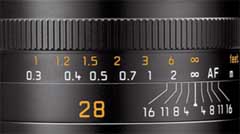 |
| |
The lines on this 28mm lens indicates the DOF. Here the focus is on infinity, and if the lens is stopped down to f/1.6, objects from 1.8 meter to ininity will be 'acceptable sharp'. |
| |
|
DOF = Depth of Field (or Depth of Focus), an expression for how deep the focus is, or (more often use to express) how narrow the area of focus is. This is how much of the image, measured in depth or ditance, will be in focus or "acceptable sharp".
The appearance of the DOF is determined by:
1) aperture (the smaller the aperture hole is, the deeper is the depth of field, and opposite, the wider open a lens you se, the more narrow will the DOF be) and
2) distance to the subject (the farther away, the larger area is sharp; the closer the subject in focus is, the more narrow the DOF gets)..
The DOF scale measurement on top of the Leica lenses shows lines for each f-stop that indicates from which distance to which distance the image will be sharp. Shallow DOF is a generally used term in photography that refer to lenses with very narrow focus tolerance, like f/1.4 and f/0.95 lenses, which can be used to do selective focus; making irrelevant subjects in the foreground and background blurry so only the subjects of essence are in focus and catches the viewers eye).
in modern cameras like the Leica SL2, the camera has a DOF scale inside the viewfinder. As DOF is the same for all lens brands and designs, only depending on focal length, distance and aperture f-stop, the camera can calculate it and show a 'digital DOF scale" in the viewfinder.
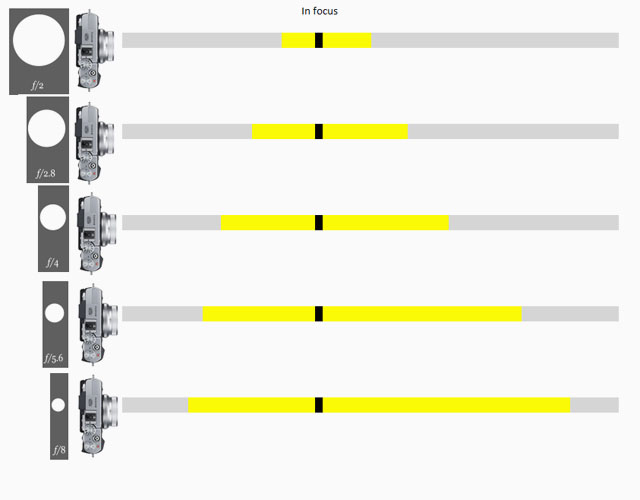
Depth Of Field scale from Fujifilm, same lens with different aperture settings from f/2.0 to f/8.0.

Depth of Field: Focus is on the flowers and the photograph on the desk and the foreground and background is blurred as the depth of field is narrow. If one stop down the aperture of the lens from f/1.4 to f/5.6, more will be in focus. If one stop down the lens to f/16 even more (if not all) will be in forcus. Another rule: The closer you go to a subject (the less focusing range), the more narrow the Depth of Field will be. © Thorsten Overgaard.
Dynamic range. The grade of ‘contrast range’ (or number of tones) a film or sensor, or simply a photograph, possess between bright and dark tones. The human eye is said to have a dynamic range of 10-14 ‘stops’ (but because we scan area by area and compile a concept of the overall scene, they eye is often thought to have a much higher dynamic range), Film used to have 7-13 ‘stops’ and some modern sensors have up to 15-17 ‘stops’.
E - Diameter in Leica filters and screw diameter, as in E46 which means that the filter diameter is 49mm for this lens. In general language, one would see Ø46 used, as Ø is the general symbol for diameter.
Elmar = Refers to the maximum lens aperture - here f3.5 . Historically derived from the original 1925 50mm f3.5 Elmax lens, which was an acronym of (E)rnst (L)ieca and Professor (Max) Berek, designer of the original lenses. Later that year the 50mm f3.5 Elmar superceded the Elmax, which was discontinued due to its complexity and high cost of manufacture.
Elmarit = Refers to the maximum lens aperture - here f2.8 . The name is obviously derived from the earlier (and slower) "Elmar" designation. Not every f/2.8 lens is called an "Elmarit" though, the most obvious current exception being the 50mm f2.8 Elmar-M collapsible lens which for nostalgia and marketing reasons has kept the original 1930's Elmar name (the 50mm f3.5 collapsible Elmar, manufactured 1930-59, was one of Leica's most famous and popular lenses). Vario-Elmarit (and Vario-Summicron, etc) is Leica Camera AG's name for zoom lenses.
Elmax
Elmax lens named after = Ernst Leitz + Max Berak. Ernst Leitz was the founder of Ernst Leitz Optical Industry which later became Leica. Professor Dr. Max Berak was employed at Leica in 1912 and was the architech of the first Leica lens which Ernst Leitz asked him to design for the "Barnack's camera" (the 1913-prototype named after Oscar Barnack who invented it). The lens was a f/3.5 50mm and was known as the Leitz Anstigmat and later the Elmax.
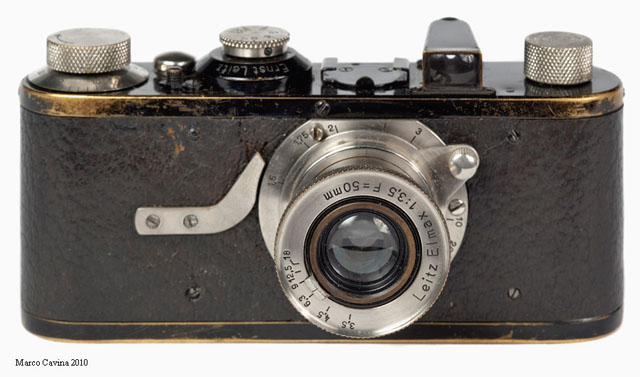
The Leitz Elmax 50mm f/3,5 (1925-1961) on the Leica A camera (1925) camera. Photo by Marco Cavina.
EVF = Electronic ViewFinder. A viewfinder where you look at a small screen through optics/prisms. The advantage is that you see what the sensor sees.
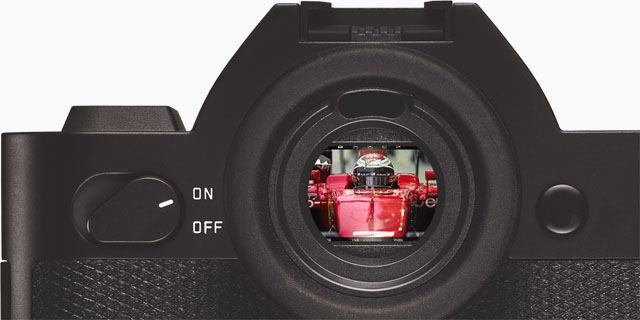
The EVF (Electronic Viewfinder) on the Leica SL 601.
EXIF =Exchangeable Image File, a file generated in camera and enclosed in the image file that contains recording information on the image such as shutter speed, exposure compensation, what metering system was used, aperture setting, ISO setting, date and time the image was taken, whitebalance, which lens was used, camera model and serial number. Some images may even store GPS information so you can see where the image were taken. The data from the EXIF file continues to follow any later editions of the image and can be read in photo editing software such as Capture One and Lightroom, as well as Photoshop (go to the menu File > File Info). There is also software available that can read EXIF data from any file, like Exifdata.com.
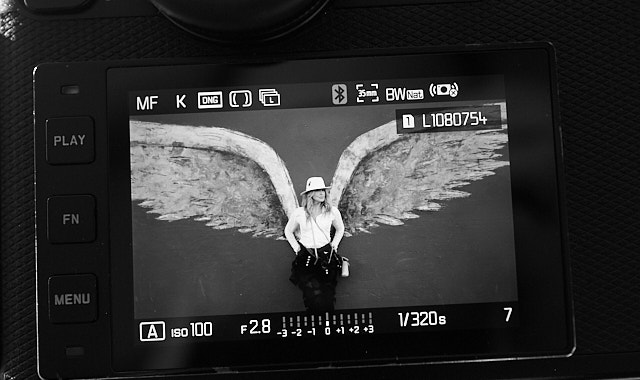
The EXIF data is all the information about shutter speed, metering method, ISO, etc. - and then some more that you don't see on the screen (such as camera model, serial number, lens used, etc).
Exposure Bracketing = The possibility to set the camera to automatically record a series of images where the exposure is above and below what the camera measures. The idea is that at least one of the images will be correctly exposed.
f/ (f-stop, also known as aperture).
f- (focal length). Often given in mm, for example 90mm. In the past they were often given in cm or inch, for example 9.5 cm or 3.2 inch.
f-stop = the ratio of the focal length (for example 50mm) of a camera lens to the diameter of the aperture being used for a particular shot. (E.g., f/8, indicating that the focal length is eight times the diameter of the aperture hole: 50mm/8 = 6,25 mm); or the other way around, the hole is the focal length divided with 8).
ORIGIN early 20th cent.: from f (denoting the focal length) and number.
One f-stop is a doubling or halving of the light going through the lens to the film, by adjusting the aperture riing. Adjusting the f-setting from f 1.4 to f.2.0 is halving the light that goes through the lens. Most Leica lenses has half f-stops to enable the photographer to adjust the light more precicely.
Filters = Glass filters you put in front of the lens. A much used filter is the claer UV filter that is supposed to protects the front of the lens. Other filters are color filters that add effects to black and white photography by changing the color balance. Other filters are ND (Neutral Density) filters that reduce the amount of light coming through (used for for example video recordings as video is usuallu filmed at 1/50th second shutter speed and thus most lenses are too bright wide open. Or they are used for long exposure photography in order to record for example stars movements over the sky. Other filters are filters that create star effects, or blur the view, and almost any effect you can think of.
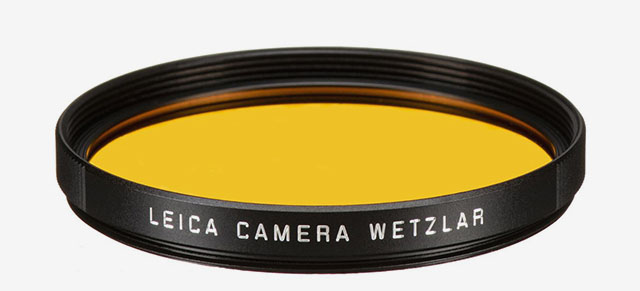
A traditional Yellow filter in 49mm diameter to screw onto the front of the lens. The yellow filter is used for black and white photography where it slightly darkens skies, helps to cut through haze, and improves overall contrast. Yellows and reds within the scene are also lightened.
Flare = Burst of light. Internal reflections between (and within) lens elements inside a lens. Mostly, flare has a characteristic "space travel" look to it, making it cool. Particularly in older lenses with less or no coating of the glass surfaces to suppress this, it can be a really cool effect. In newer lens designs, the coatings and overall design try to suppress flare and any reflections to a degree, so that there is seldom any flare to be picked up (moving the lens to pick up a strong sunbeam), but instead a "milking out" (or "ghosting") of a circular area of the frame; meaning simply overexposed without any flare-looking flares.
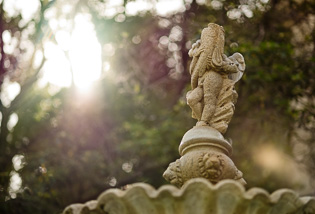 |
|
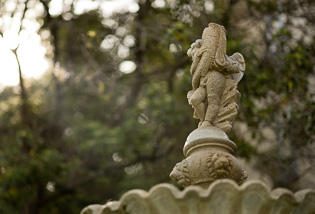 |
Sunlight creating (fairly supressed) flare in the bottom right quadrant of the image of a modern lens. |
|
The camera moved slightly to avoid the flare. |
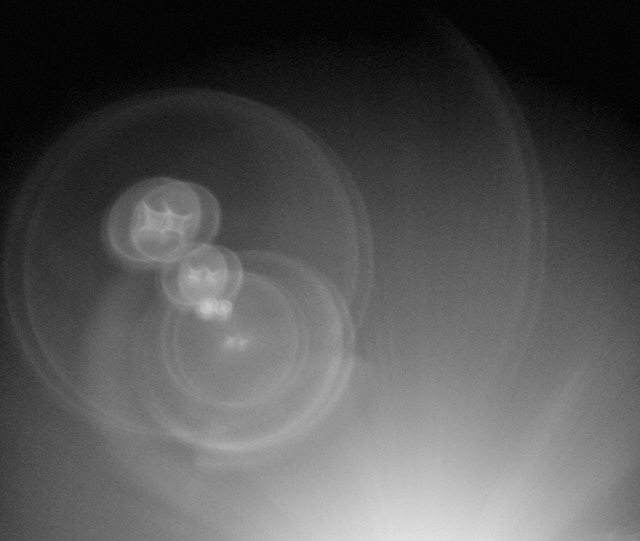
Older lenses with less coating, or without coating, are known to create flare that can look like this (Leica 50mm Summicron-M f/2.0 II Rigid model from the 1960's). © Thorsten Overgaard.
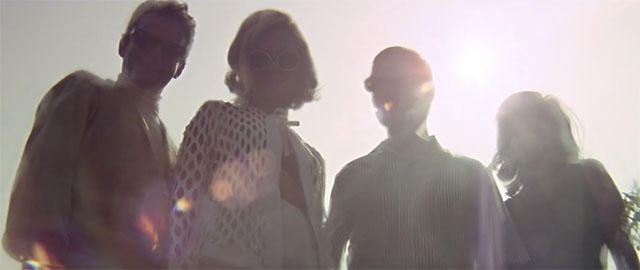
Lens flare in the movie, The Graduate (1967).
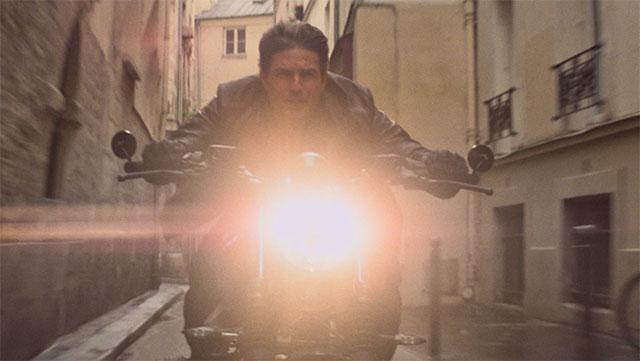
Lens flare in Mission Impossible Fallout (2019)

Lens Flare in Star Trek (2013). JJ Abrams famously said, "I know there's too much lens flare ... I just love it so much. But I think admitting you're an addict is the first step towards recovery (ha ha)"
|
FLE = See "Floating Elements"
Flickering in the EVF is very normal and will apear often without the vertical lines you see in the EVF will be in the picture.
| |
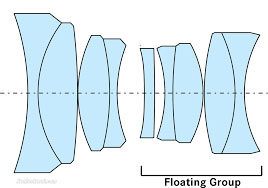 |
| |
Floating elements (a group of lenses or can also be s aingle lens element). . |
Floating Elements (FLE) = Near focus correction in a lens by having a single lens or a group of lenses floating independently of the other lenses. Most lenses are born with poor performance at their closest focusing distance. Center sharpness may be good, but aberrations and corner softness increase when you’re shooting closeups. Floating elements are lens elements outside of the primary focus group that change position when the lens is focused on a close object, correcting aberrations and improving close up performance.
Floating Elements originally was coined by Canon in the 1960's and quickly became the general term for this feature. Other brands came up with new names for the same thing, Minolta called it Floating Focusing, Nikon used the term Close-Range Correction (CRC), Leica call it FLE/Floating Elements.
Floating elements are for close-focus improvement of image quality and not for reducing "focus shift". Floating elements by themselves cannot reduce focus shift, but by reducing the impact of focus distance on performance, they give the designers more freedom in other areas - which could include minimising focus shift.
(As a side-note, when a lens "rattler when moved, it is not the floating elements "floating around" but can be the IS (Image Stabilization) elements for elense that has that, AF elements for auto focus lenses, or the aperture cage that rattles (as in the case of the Leica 35mm Summilux-M f/1.4 FLE - if you stop down the Summilux to f/16, the sound is usually not there).
| |
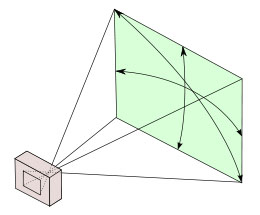 |
| |
A 28 mm lens has a 74° viewing angle |
| |
|
Focal length = Originally focal length referred to the distance from the sensor (or film in older days) to the center of focus inside the lens (28mm, 50mm, 400mm, etc). Today one call it effective focal length (EFL) as a 400mm lens is not nessesarily 400mm long due to optical constructions that can make it shorter. The 35-420mm zoom on the Leica V-Lux 1 is for example only ca. 135 mm long. Nobody uses that measurement, except those who construct lenses! For users of lenses, focal length refers to how wide the lens sees. The viewing angle, which is often given in for example 90° viewing angle for a 21mm lens, 74° viewing angle for a 28mm lens, 6° viewing angle for a 400mm lens, etc.
Each human eye individually has anywhere from a 120° to 200° angle of view, but focus only in the center.
Focus, in - Sharp and clear in appearance. Focus - “The burning point (of a lens or mirror)”. In Latin the word focus meant fireplace or hearth. The word was probably first employed outside of its Latin literal use as “the burning point of a lens or mirror” in optics, and then came to mean any central point. The German astronomer Johannes Kepler first recorded the word in this sense in 1604.
Focus shift = That the focus of a lens shifts as the aperture changes. For example, if one focus a 50mm lens at f/2.0 and then stop the aperture down to f/8, the focus may change, especially noticeable in close focusing. Modern lenses with floating elements (FLE) where the floating elements adjust for image quality in close-focusing may also help avoid focus shift.
Four Thirds - Also known as "4/3" - The Four Thirds System is a standard created by Olympus and Kodak for digital SLR camera design and development.
The system provides a standard which, with digital cameras and lenses available from multiple manufacturers, allows for the interchange of lenses and bodies from different manufacturers. Companies developing 4:3 cameras and/or lenses are Fuji, Kodak, Leica, Olympus, Panasonic, Sanyo, Sigma. See www.4-3system.com
A further development in this was Micro Four Thirds Systems.
Frame lines = the lines inside a viwfinder that indicates the edger of the frame. In a Leica M, the viewfinder always is as wide view as 24-28mm. A mechanical contach on the lens (triggers the camreas frame selector) so the viewfinder shows the frame line of that lens. In the Leica M, the frame lines comes in sets, so there are alwaus twop sets of frame lines shown at any time (see illustration below).
(This is different than in most cameras where you only see what the lens captures: SLR cameras was the evolution in 1940's where the image from the lens was displayed directly onto a matte screen inside the camera via a mirror.
Later mirrorless cameras, the viewfinder shows the exact picture that the sensor sees through the lens).

Frame lines of the Leica M, here showing the set of 35mm and 90mm framelines.
| |
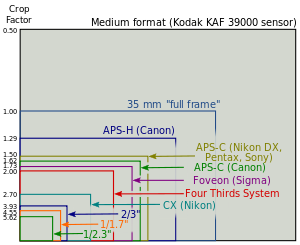 |
| |
Full Frame is "king of photography" |
| |
|
Full Frame (FF) = The size of the sensor is 24 x 36mm which is the format Oskar Barnack and Leica Camera AG invented with the first Leica that was introduced in 1925. Many other formats invented since, such as APS, APS-C and all usually refer to Full Frame ratio, by which it means what size they have compared to Full Frame. The "full frame" technically deifinition thouhg is a sensor that camtures the full frame in one go (as the early sensors as in Leica S1 scanned the image/senor over a period of time).
The 24 x 36mm Full Frame format is so "king of photography" that it has continued to be the ideal for all cameras. Besides this, there exists Large Format cameras such as 4x5" (100 x 125 mm) and Medium Format 6x6 (60 x 60mm amongst other sizes in that area).
Ghosting = Secondary light or image from internal reflections between (and within) lens elements inside a lens. The reflected light may not always be in focus, so overall it looks like a "milked out" image. A subject in focus has brightened patches in front of it that come from reflections inside the lens. the most elementary look of ghosting is when you look in a rear-view mirror in a car at night and you see doubles of the headlights behind you (a strong one and a weaker one), because the headlights are reflected in a layer of clear glass on top of the mirror glass.
 |
|
 |
|
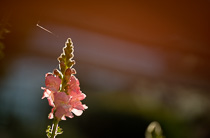 |
| Degrees of ghosting from strong sunlight entering from outside the frame. To the right the outside light has been shielded with a shade. |
ISO = Light sensitivity of the camera sensor is given in ISO (International Organization for Standardization). It's a standard that was used in film and is now used in all digital cameras also. The base ISO for the Leica TL2 sensor is around 100-150 which means that this is what the sensor "sees". All other levels are computer algorithms calculating the effect as if the sensor could "see" more (hence noise at higher ISO levels).
ISO goes in steps of doubling: When the ISO is raised from 100 ISO to 200 ISO, the camera only need half the amount of light to make the same picture. For each step in ISO to 400, 800, 1600, 3200, etc. the light sensitivity is doubled for the sensor (and the camera sensor only need half the light of the previous ISO to record the same image).
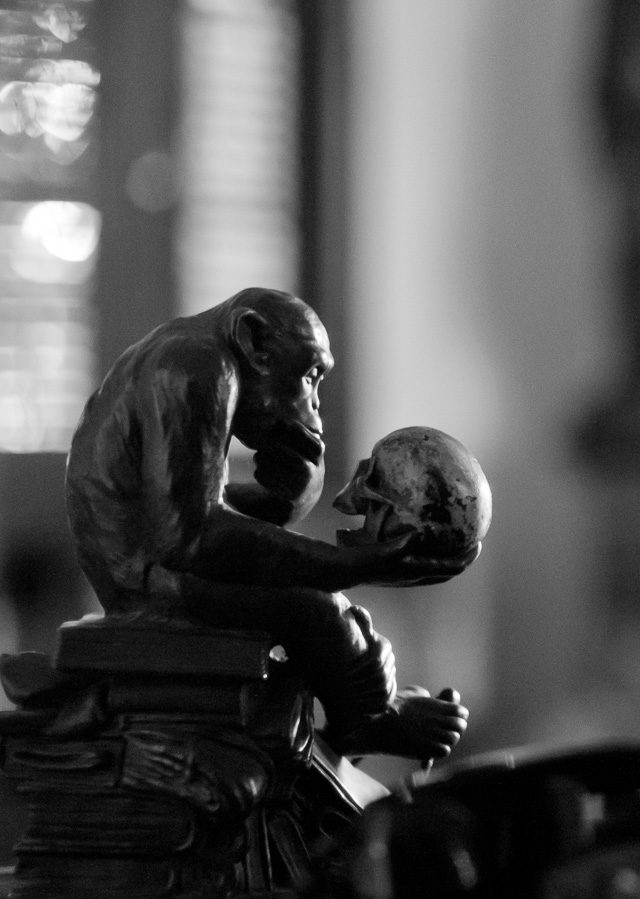
6400 ISO indoor photo. With modern cameras the ISO can go to 3200, 6400, 12,800 and even higher without loss of dynamic range and without digital noise. Leica M10 with Leica 50mm Noctilux-M ASPH f/0.95. © 2017 Thorsten Overgaard.
JPEG = A standard for picture format made in the 1990's by Joint Photographic Experts Group). Mostly referred to as JPG as in L1003455.JPG which would be the name for a JPG file from the camera.
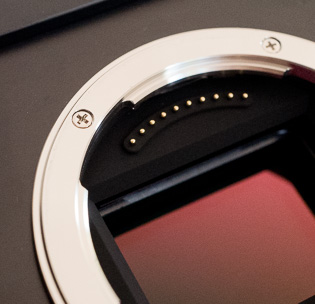
Leica L-mount bayonet. |
L-mount = Lens bayonet mount introduced by Leica for the Leica T in 2014 and used for Leica TL, Leica CL and Leica SL. Since 2019 the L-mount has also been shared with Panasonic, Sigma and others who produce cameras and lenses that are compatible with Leica L cameras and lenses lenses, and vice versa.
The L-mount has a diameter of 51.6 millimeter which is big enough for any design we could wish to design, and at the same time compact enough for the L-mount to be used on compact cameras such as Leica TL and Leica CL with APS-C sensor sizes. Leica chief lens designer Peter Karbe spent years calculating this ideal size, large enouhg for any design, yet as compact as possible. Read my article "Small Camera, Large Print" (2019) with interview with lens designer Peter Karbe for more.
After Leica introduced this new bayonet mount in 2014, Nikon (Z-mount 55mm), Fuji (G-mount 65mm) and Canon (RF-mount 54mm) followed with similar new bayonet mounts, but with bigger diameter, making them less able to produce compact lenses.
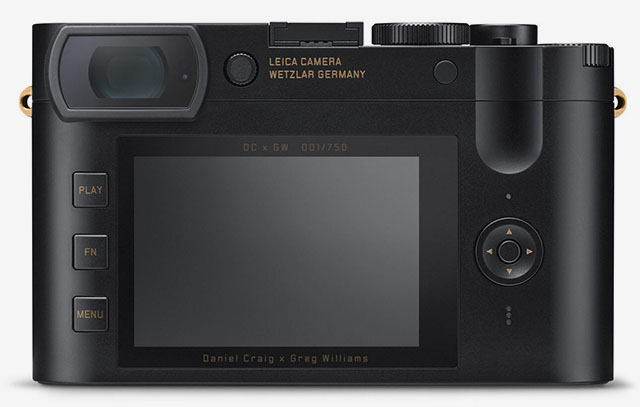
A screen on a camera is often referred to as "LCD Screen" for no particular reason (illustration is the back of the Leica Q2 special limited "James Bond/Daniel Craig & Greg Williams" version (2021).
LCD = Screen. LCD itself means liquid crystal display, which is slightly irrelevant (what it is made of) as the expression is mostly used to simply mean "screen".
Leica = A compound word derived from " (Lei)tz" and "(ca)mera". Apparently they were originally going to use "LECA", but another camera company already used a similar name in France, so they inserted the 'i' to prevent any confusion.

The word lens derives from lentil, because of the similar shape.
Lens - A piece of glass or similarly transparent material (like water or plastic) that has a shape so that it can direct light rays. The word “Lens” is used both for single piece of glass as well as a camera lens with several lenses that works together. From ‘lentil’ because similar in shape.
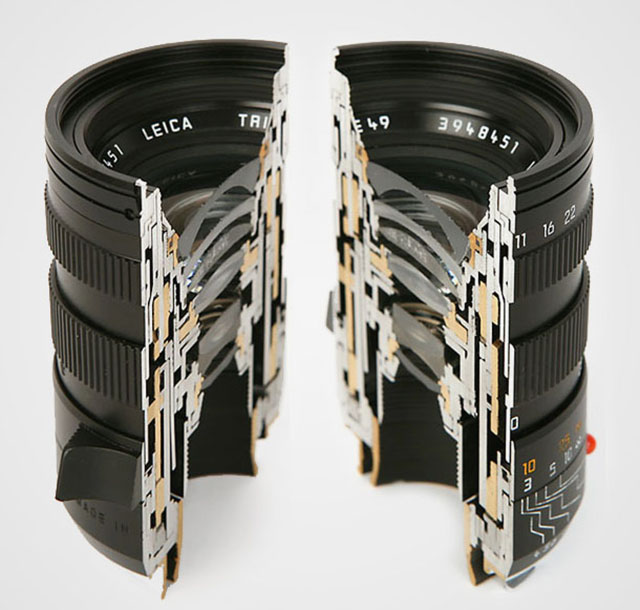
A camera lens consists of several shaped lens elements of glass. The lenses can also be made of simple cheap plastic as in "kit lenses" (sold with a camera as a kit to make a workable cheap package), but it is mostly very exotic glass (that can be heavy or light in weight, very hard or very soft in surface (esay to scratch or very resistant) with each optical glass recipe made to develop very specific qualities in how the glass and final lens treats light. As a general rule, high quality glass is soft, which is why some lenses has as their front and back element, a non-optical lens element that is there to protect the actual optical glass from scratches. As a side noite, Leica made their own glass laboraty, The Leitz Glass Laboratory, from 1949-1989, which deveopled 35 new glass types and took out more than 2,000 patents of glass recipes from more than 50,000 experimental melts of glass. These designs, or recipes, are still used today by the lens designers to obtain very specific optical results. Other lens manufacturers in the world of course have had their glass laboratories, and today one will find an interchange of glass patents amongst production facilities that service Leica, Nikon,, Fuji and so on with optical lens elements.
Lens hood = (also called a Lens shade or Ventilated Shade). A tube or ring attached to the front of a camera lens to prevent unwanted light from reaching the lens and sensor. In the past where lenses were not coated to prevent internal reflections inside the lens, the lens hood was often essential. These days where lenses are coated, the shade serves just as much as decoration and protection (bumper) as well.
ORIGIN Old English hod; related to Dutch hoed, German Hut 'hat,' also to hat.
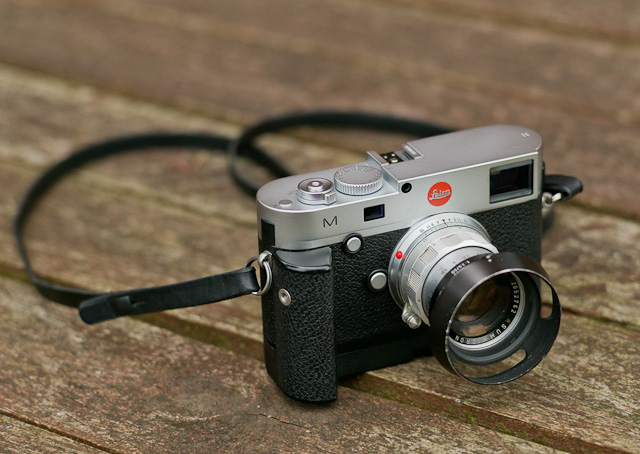
Lens hood or Lens shade or ventilated shade. In the picture is a ventilated shade with clip-on mount to a 50mm f/2.0 lens. Ventilated means it has openings that allow for view from the viewfinder.
Lens names of Leica distinguish which widest aperture the lens has:
| Noctilux |
f/0.95 - f/1.25 |
| Nocticron |
f/ 1.2 (Leica-designed Panasonic lens) |
| Summilux |
f/ 1.4 - f/1.7 |
| Summicron |
f/2.0 |
| Summarit |
f/2.4 - 2.5 |
| Hektor |
f/1.9 - f/6.3 (used 1930-1960 for screw mount lenses only) |
| Elmarit |
f/2.8 |
| Elmar |
f/2.8 - f/4.5 |
| Elmax |
f/3.5 (only used 1921-1925 for the 50mm Elmax f/3.5) |
| Telyt |
f/2.8 - f/6.8 (used for tele lenses) |
Light = Tiny particles called photons that behaves like both waves and particles. Light makes objects visible by reflecting off of them, and in photography that reflecting off of subjects is what creates textures, shapes, colors and luminance. Light in its natural form (emanating from the sun) also gives life to plants and living things, and makes (most) people happier. So far, nobody has been able to determine exactly what light is. The word photography means “writing with light” (photo = light, -graphy = writing). Read more about light in my book Finding the Magic of Light.
Live View = This is the ability to see the image the sensor see, live, via the screen on the back of the camera, or via an electronic viewfinder (EVF).
LMT - Leica Thread-Mount: Also known as M39, is the screw mounted lenses for Leica cameras. It’s a simple as that; you screw on the lens, and back in 1932, the possibility to change the lens was the big news hwen introduced by Leica on the Leica III. The M39 system was updated with the M Bayonet from 1954 for the Leica M3. The M bayonet is a quick way to change lenses and is the current mount for Leica M digital rangefinders.
M (as in "M3", "M6", "M7" etc.)
A) The M originally stands for "Messsucher", which is German "Meßsucher" for "Rangefinder". The "3" in M3 was chosen because of the three bright line finders for the 50, 90 and 135 mm lenses. Later the numbers of the M cameras were more or less chosen to follow each other.
M-body evolution in chronologic order:
M3 - MP - M2 - M1 - MD - MDA - M4 - M5 - CL - MD-2 - M4-2 - M4-P - M6 - M6 TTL - M7 - MP - M8 - M8.2 - M9 - M9-P - MM (black and white sensor) - ME (Type 220) - Leica M (Type 240) - Leica M-P 240 - Leica M 246 Monochrom - Leica M-A (type 127, film camera) - Leica M 262 - Leica M-D 262 (without a screen) - Leica M10 - Leica M10-P, Leica M10 Monochrom, Leica M10-R.
B) M also refer to M-mount as the M bayonet that couple the Leica M lenses to the Leica M camera. Before the M bayonet the coupling between the camera and lens was screwmount.
C)
M nowadays refer to the Leica M line of cameras rather than the "Messsucher".

The Leica M bayonet on the Leica M10.
- M-mount: The Leica M-mount is a bayonet that was introduced with the Leica M3 camera in 1954 and has been used on all subsequent Leica M cameras, as well as on the Epson R-D1, Konica Hexar RF, Minolta CLE, Ricoh GXR, Rollei 35RF, Voigtländer Bessa, and Zeiss Ikon cameras (2019).
Compared to the previous screw mount (M39), the M
mount requires a quick turn of the lens, and ithe lens is mounted. The patent for the M-bayonet ("Bajonettvorrichtung für die lösbare Verbindung zweier Kamerateile") was registered by Ernst Leitz GmbH 10 February 1950 (patent number DE853384). Hugo Wehrenfennig was credited with the invention.
M9
Leica M9 is a model name for the Leica M9 that was introduced on September 9, 2009 (as the first full-frame digital Leica M). It was the latest model designation using the M and a number. From their next model, Leica Camera AG introduced a new model system so each camera would simply be a Leica M but then with a model designation like Typ 240, Typ 246, Typ M-D 262 and so on. The idea was inspired from Apple who name their computers for example MacBook Pro and then it has a sub- model number designation which model it is (and which would define speed of processor, etc).
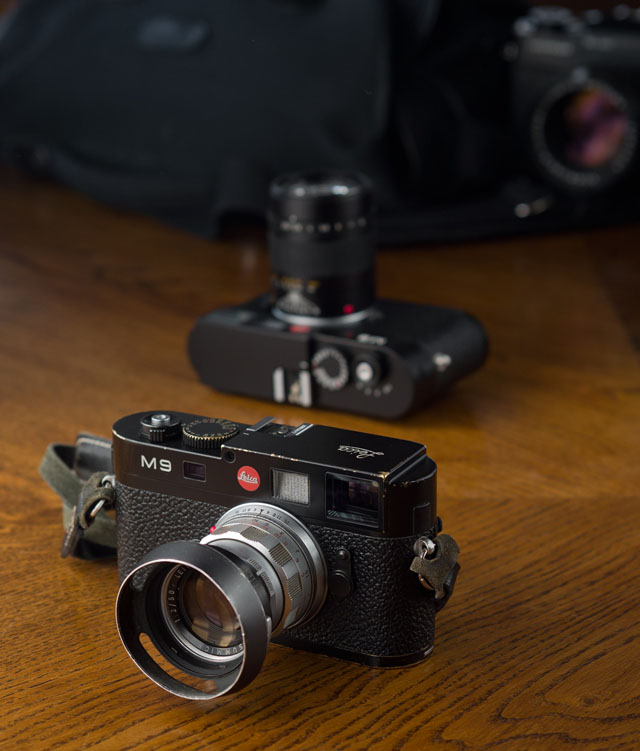
Leica M9 digital rangefinder (2009). © Thorsten Overgaard.
MACRO = Macro lens. The Leica 60mm APO-Elmarit-Macro-R ASPH f/2.8 is a 60mm lens for portraits, landscapes, etc. as well as a near focus macro lens. The Leica Q lens can be turned to Macro which enables you to go close so as to enlarge smaller subjects. The Leica M cameras becomes Macro when you add a Macro ring "Oufro" or "Leica Macro M Adapter" that increases the lens' distance to the sensor. The word macro comes from Greek makros ‘long, large.’
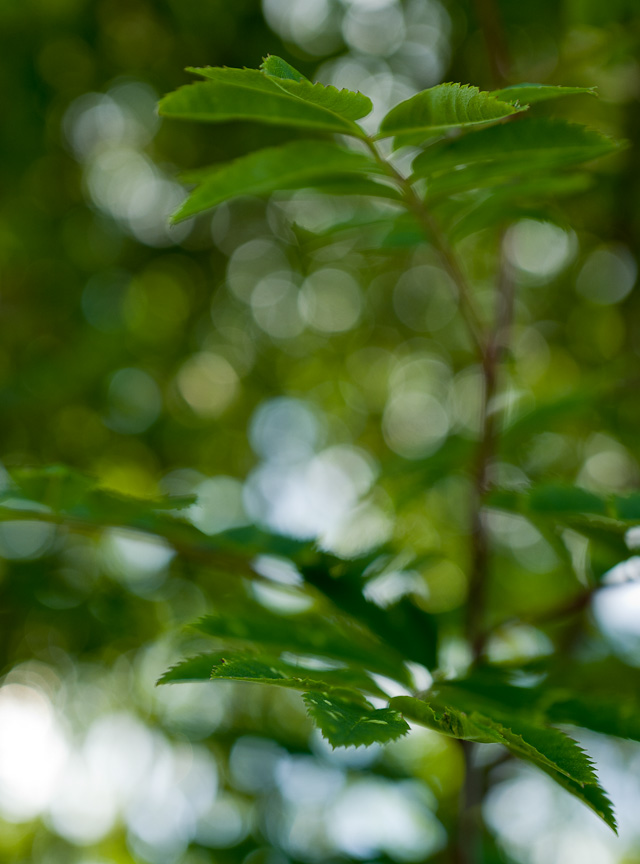
The word macro comes from Greek makros ‘long, large.’ The Leica 60mm APO-Elmarit-Macro ASPH f/2.8 is both a 60mm lens for portraits, landscapes, etc. as well as a near focus macro. © Thorsten Overgaard.
Mandler, Dr. Walter (1922 - 2005)
Legendary Leica lens designer and CEO of Ernst Leitz Canada (ELCAN) 1952-1985. Read more in Leica History.
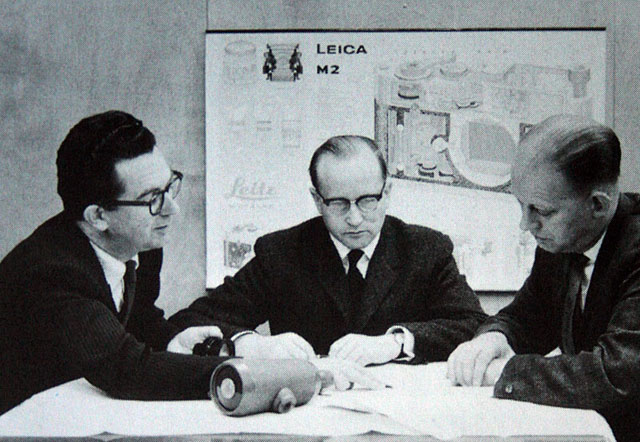
Dr. Walter Mandler (center) at the Ernst Leitz Camera factory.
Megapixel (or MP) - Millions of pixels. See pixel further down. How many units of RGB is recorded by a given sensor by taking height x widt. A Leica M10 delivers a 5952 x 3968 pixel file = 23,617,536 piexls. On a screen the resolution you choose determines the size of the image. Say you have a 5000 pixel wide file and your screen is set for 8000 pixels wide. Then the image will fill only the 5000 pixels fo the 8000 and the rest will be empty, If you then change the screen resolution to 5000 wide, the image would be able to fill out the whole screen.
Meßsucher = (rangefinder or distance finder) = Mess = range, sucher = finder. It is always correctly written with the "ß". There are technically not three "s", rather the "ß" and one "s" because it is a word constructed by the combining of two precise words.
MF (Manual Focus) for lenses that are focused by hands, as opposed to Auto Focus.
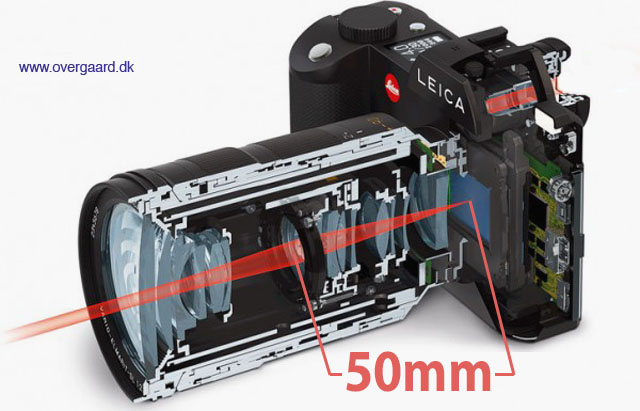
Focal length is determined by the distance from focus inside the lens to sensor surface to, and is given in milliemeters (mm). © Thorsten Overgaard.
mm = millimeter(s), as in a 50mm lens. (Earlier in lens history lenses focal length was given in cm = centimeters; as in a 5 cm lens). For anyone used to centimeters and millimeters, it’s no wonder. But if you grew up with inches, feet and yards, you may have had a hard time grasping what a 50mm lens was. But as lenses were designed first in Europe, the metric system with centimeters and millimeters was used to describe lenses.
(Leica and others made lenses for a while with either meter scale or feet scale; but then eventually started including meter and feet on all the lenses (two scales, usually distinguished with different colors). However, the lens' focal length remained always 50mm, 75mm and so on).
The reason a 50mm lens is a 50mm lens is that there is 50mm from the focus plane (the film or sensor surface) to the center of focus inside the lens. When photography was a young subject, it was engineers who made it all, and the users were expected to understand. The engineers were so into the making of the lenses, that it apparently never dawned upon them that today’s users would think of a 21mm lens as a wide angle lens rather than a lens where there is 21mm from the sensor to the center of focus inside the optics.
MP
a) Stands for Mechanical Perfection, as in the Leica M-P.
b) Megapixels (millions of pixels).
c) Megaphotosites (millions of photosites).
ND
Neutral Density filters are grey filters function as 'sunglasses' for lenses. They simply block the light so that a lens can work at for example f/0.95 or f/2.0 in sunshine.
If a camera is set to 200 ISO and the maximum shutter speed is 1/4.000, this will usually result that the lens has to be at f/2.8 or smaller aperture in sunshine. Else the image will over-exposed. So in order til stay within the maximum shutter speed of 1/4.000 and still use a lightstrong lens wide open, one mount a ND-filter that reduce the light with 3 stops (8X) or 6 stops (64x).
For video ND-filters are used quite a lot (as the shutter speed for video is 1/60), and ND-filters are also used to reduce the light for really long multi-exposures at night (stop-motion video and stills).
ND-filters also exist as variable ND-filters so one can adjust the amount of light going through from for example 1 stop (2X) to 6 stops (64X).
ND-filters also exist as graduated ND-filters where the top of the filter is dark and then gradually tone over in no filter (so as to reduce the skylight in a landscape for example).
The ND filters are called Neutral because it is a neutral filter. It doesn't change colors, only the amount of light.
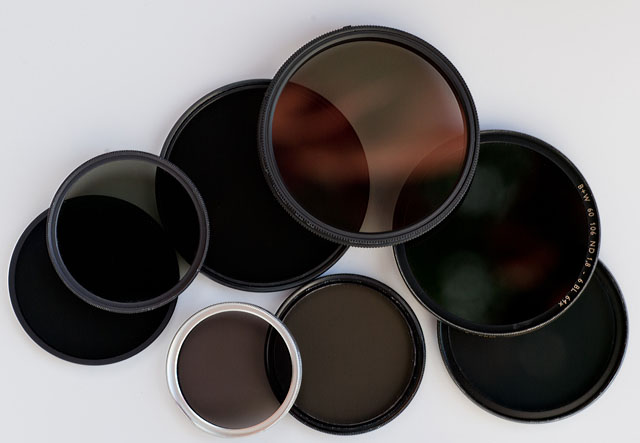
ND-filters / gray-filters.
Noctilux = Also known as "King of the Night" because "Nocti" means Night and "Lux" means Light. The f/1.0 lenes from Leica are named "Noctilux". The first Leica Noctilux lens was the 50mm Noctilux f/1.2 which shortly after it's introduction was improved to the 50mm Noctilux f/1.0. In the current model the f-stop has been improved further to f/0.95.
"Noctilux" refers to the maximum lens aperture - here f1.0 . "Nocti" for nocturnal (occurring or happening at night; ORIGIN late 15th cent.: from late Latin nocturnalis, from Latin nocturnus ‘of the night,’ from nox, noct- ‘night.), "lux" for light. The Leica Noctilux 50mm f1.0 is famous for enabling the photographer to take photos even there is only candleligts to lit the scene. See the article "Leica Noctilux - King of the Night"
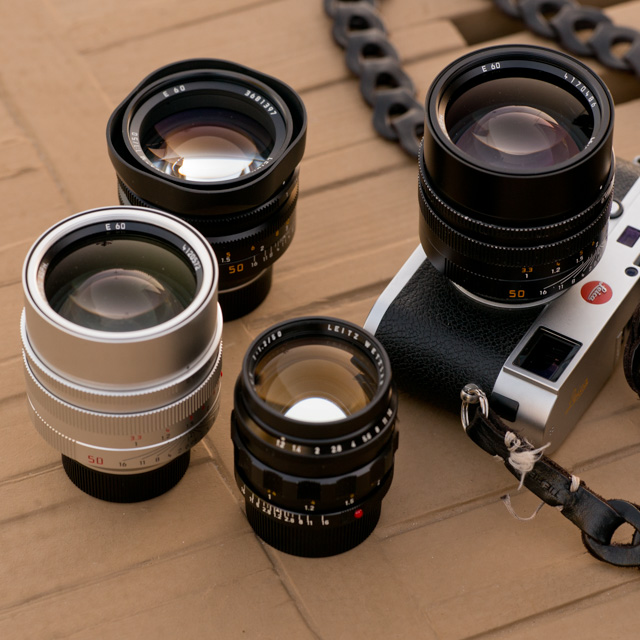
The Noctilux "King of the Night" lens. From left the f/0.95 in silver (same on the camera, in black), the f/1.0 in the back and the rare and expensive first model, the f/1.2 in the front.
No.
Number, on this site Leica catalog numbers or order numbers. Some the numbers changed depending on the number of cams in the lens: The Elmarit-R f2.8/135mm started life as No. 11 111, however when fitted with 2 cams for the SL became No. 11 211, yet another No. for the 3 cams lens and a fourth number for 3 cam only at the end of its life. Number changes also applied to M lenses depending on whether they were screw-thread, bayonet or for M3 with “spectacles”. Thus the No. in the Thorsten Overgaard Leica Lens Compendium list is a guideline but not a comlete list of existing catalog numbers.
Optic = Eye or vision. From French optique or medieval Latin opticus, from Greek optikos, from optos ‘seen.’
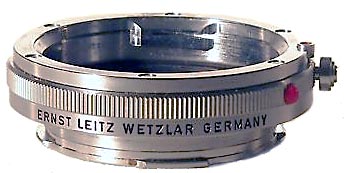
Oufro (model 16469Y)
An original Leitz Extension Ring (produced 1959-1983 as part no. 16469). Used with Oubio for all the longer (125mm+) Visoflex lenses and without OUBIO for 35/50mm. OUFRO can be stacked for greater magnification and will work on the Leica M Type 240 as macro for all lenses (including the Noctilux, 90mm APO-Summicron and even 21mm lenses).
 The OUFTO on Leica M Type 240 with Leica 90mm APO-Summicron-M ASPH f/2.0. The OUFTO on Leica M Type 240 with Leica 90mm APO-Summicron-M ASPH f/2.0.
Perspective = The way objects appear to the eye; their relative position and distance. Also, selective focus (foreground and background out of focus) can change the perception of perspective (also see Three-dimensional). A wide angle "widens" the perspective and makes objects further away appear smaller than they are to the eye; and objects closer, relatively larger than they are to the eye. A tele lens will "flatten" the perspective and often objects further away will appear relatively larger than close objects than they are in real life. A 50mm lens is the one closest to the perspective and enlargement ratio of the human eye.
The word Perspective comes from the latin word for optics (perspicere, per- ‘through’ + specere ‘to look’), and so-called Renaissance painting is simply painting done within the framework of optics and the linear perspective it presents.
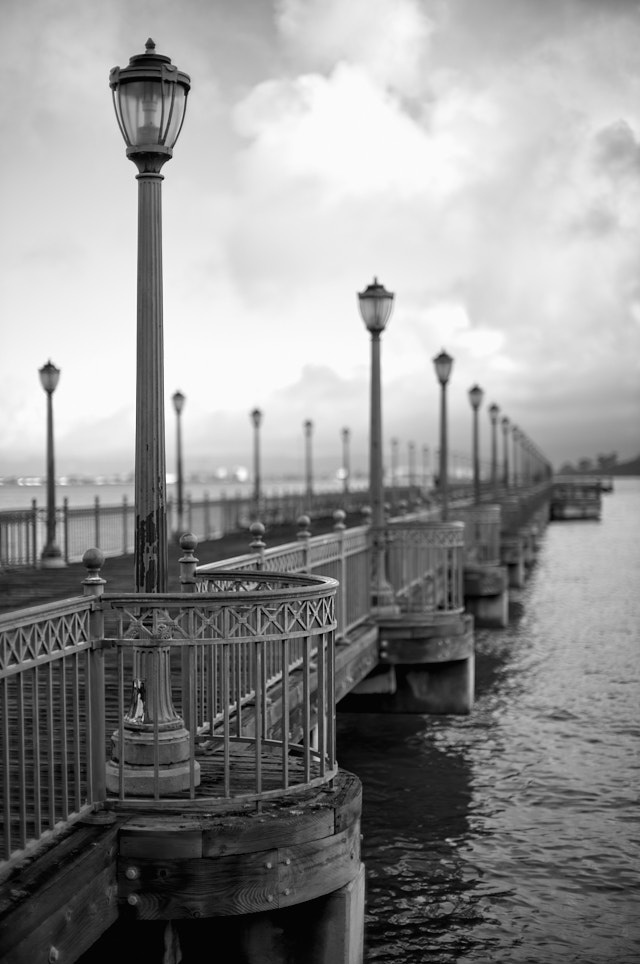
Perspective is relative position and distance. The objects nearby are larger than objects far away. This is how the eye and the mind calculate distance. The eye and the camera automatically captures perspective. In darwing and painting one would see "stupid" two-dimensional drawings 500 years B.C where elements were thrown into the mix without considering that a an object far away must be smaller than if close to the viewer. The word "perspective" comes from "to look through (optics)". Pier 7 in San Francisco by Thorsten Overgaard. Leica M11 with Leica 50mm Noctilux-M ASPH f/0.95.
| |
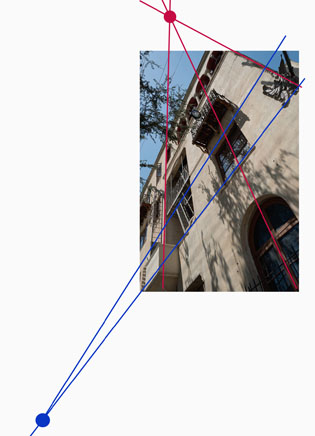 |
| |
Vanishing points are the points where lines meet. This is how you make perspective in paintings and drawings (and some times make movie sets or theatre stages appear more three-dimensional than they are) |
| |
|
Painters works with vanishing points, which is where the lines meet, so as to create an illusion of perspective and three-dimensional effect on a two-dimensional painting or drawing.
The human eye corrects for perspective to an extreme degree. We always see vertical lines vertical and horisontal lines horisontal: The eye has a angle of view equivalent to an 8mm wide angle lens, a size ratio equivalent to a 50mm lens and we focus on relatively small area of the viewing field - one at the time. Three things happens that are worth paying attention to:
1) We compile areas of our view that we focus on, to one conceptual image that "we see". Ansel Adams, the great American landscape photographer pointed out that a large camera used for landscape photography capture every detail in focus and sharp so you can view it in detail after; but the eye does not see everything in focus when you try to compose the landscape photography, the eye scans only one part at a time and stitch the idea together. This makes composing or prevision of a landscape photography challenging.
2) We compile areas of our view that we individually adjust the exposure of. A camera adjust the exposure of the whole image frame to one exposure. That's why what looks like a nice picture to the eye of houses in sunshine with a blue sky above, becomes a photograph of darker buildings with a bright white sky: The camera simply can't take one picture that compare to what we "compiled" with our eyes, adjusting for each type of light.
3) Objects (on a table, for example) in the bottom of our viewing field will appear 100% perspective corrected - to a degree that it is impossible to correct in optics, with or without software correction. A wide angle lens, even with little distortion, will exaggerate the proportions of the closet part so it - to the eye - looks wrong.

Perspective distortion: Comparing these two photographs you can see how the cup stretches in the 28mm wide angle photograph compared to the 50mm photograph. Both actually has a little stretch because both the cup is in the edge of the frame in both photographs. © Thorsten Overgaard.
Perspective correction - In software like Adobe Lightroom and Capture One Pro there is often a feature to correct perspective (and distortion) like seen below. You can change perspective this way, or at least make believe: If you correct a tall building on teh vertical lines, you will notice that the height of the windows doesn't match the perspective. If the building is with straight lines, the windows should all be of the same size. But a tall building seen from below and corrected with software will have taller windows (closer to camera) in the bottom than in the top (further away from the camera originally).
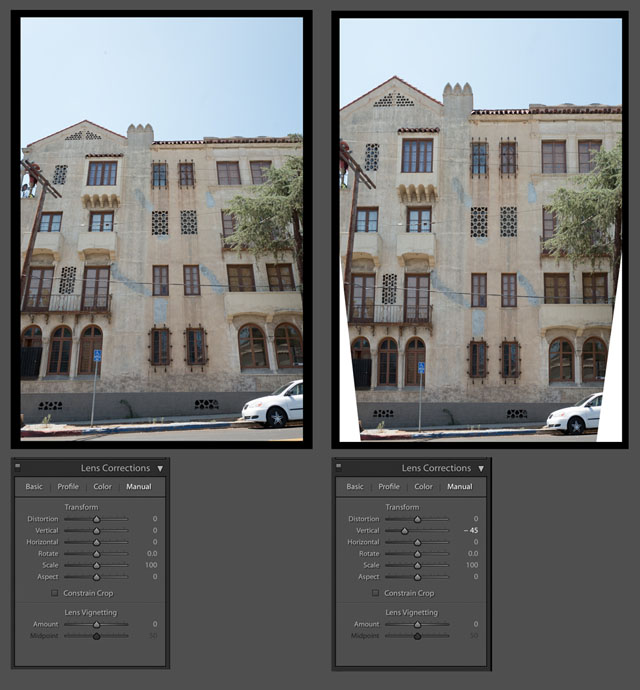
Perspective correction in Adobe Lightroom. © 2017 Thorsten Overgaard.
| |
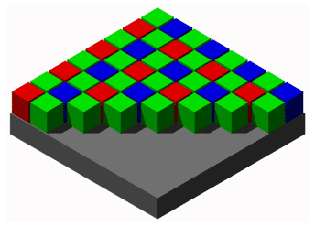 |
| |
A graphic illustration of the typical Bayer Color Filter Array on an RGB sensor. It's called a Bayer filter because Bryce Bayer of Eastman Kodak invented the technology of filtering incoming light into RGB and distribute it into the the photosites that each read just one color (R/G/G/B). |
| |
|
Photosite - The unit in a digital camera sensor that records intensity of either red, green or blue. Unlike the output of a sensor, measured in pixels (and where each pixel contains RGB), the photosite records only one color each, and it's intensity (how bright it is). A photosite can not distinguish colors, which is why there is a Color Filter Array (basically a prism) above them to filter the colors and send information to the photosite if 's a R, G og B color. See illustration below. In a monochrome sensor (as in the Leica M Monochrom and the Phase One Achromatic), all photosites are recording intensity of light only as there is no concern which color it is, and there is no color filter.
The ratio of photosites to pixels is not a given. Each block of 4 contiguous photosites contains one photosite sensitive to low wavelengths (blue), one photosite sensitive to high wavelengths (red), and two identical photosites sensitive to medium wavelengths (green). So four photosites would be the minimum to create one 'full-color' pixel. Apart from that, depends on the sensor specifications, which is different from brand to brand. Sometimes four photosites (two Green, one Red and one Blue) makes up one pixel, at other times it's more photosites to one pixel; and there is also pixels sampled from photosites across (sort of overlapping patterns).
Pixel - Made up word from Pix (picture) and el (element). A pixel is the smallest full-color (RGB) element in a digital imaging device. The physical size of a pixel depends on how you've set the resolution for the display screen. The color and tonal intensity of a pixel are variable, meaning that each pixel contains RGB. This is different from a camera sensor's small eyes (photosite) that are an intensity of either red, green or blue. You could say that the digital sensor's photosite (where each unit collects just one color; red, green or blue) is the input technology, whereas the pixels on a screen (where each pixel contains red, green and blue) is the output device. So while sensors are measured in megapixels (mega = million), it's their output unit of pixels, and not the input unit of photosites that is measured and stated. See illustration below.
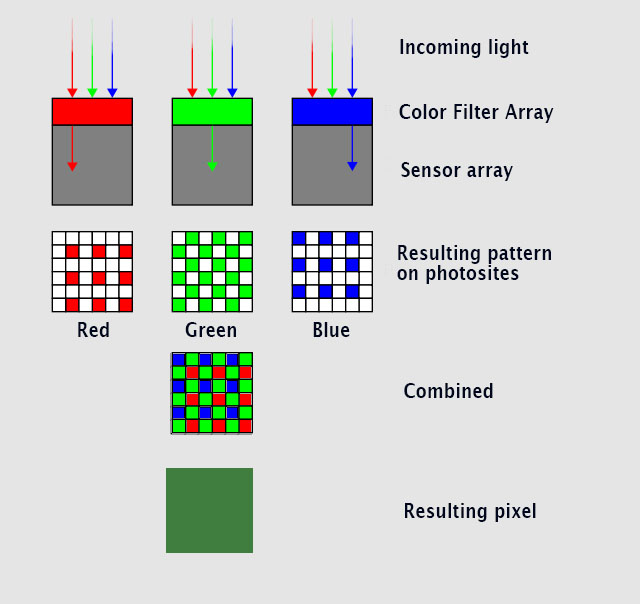
Here's an illustration of how light goes through a color filter that enables the underlying photosites to each record if it';s an R, G or B color - combined - makes up one pixel containing RGB. © Thorsten Overgaard.
R = Resolution, in the name Leica M10-R camera model (2020).
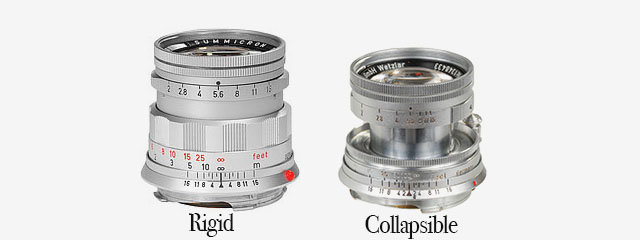
Rigid - Refers usually to the Leica 50mm Summicron-M f/2.0 "Rigid" of 1956.
It is called "Rigid" because, unlike the 50mm Collapsible, this one is not able to be changed.
Rigid means stiff, uable to be forced out of shape. Not able to be changed. From Latin rigere, "be stiff".
The name is a little confusion nowadays as all or most lenses are rigid today, but back in 1925-1956, many lenses were collapsible so the camera was compact when not in use. Just like compact cameras today often has a lens that extrudes when the camera is turned on, and collaps into the camera body when the camera is turned off.
RF
(R)ange (F)inder - the mechano-optical mechanism which allows M Leicas to focus.
Alternative meaning - RF is also shorthand for Hexar RF , Konica's motorised "M-lens-compatible" rangefinder camera released in 2000.
S = Single image. When the ring by the shutter release on top of the camera (or in the menu of a digital camera in case it does not have this ring on the ourside) is moved from OFF to S, the camera takes only one photo at the time (Single). The other possibility is Continuous where the camera takes pictures continiously as long as the shutter release button is helt down. (see above).
Saturation: How colorful, intense or pure the color is. Less saturation would be less colorful, more saturation would be more colorful. In today’s photography, de-saturating a photo on the computer will gradually make it less and less colorful; and full de-saturation would make it into a black and white photo.
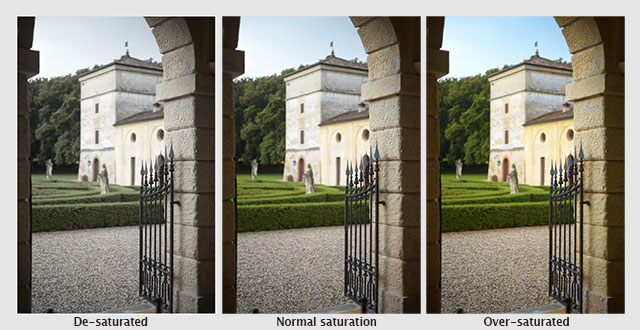
A photo from Verona, Italy de-saturated, normal saturated and over-saturated. © Thorsten Overgaard.
Sensor = A device that detects a physical property (like light) and records it. A camera sensor is a plane plate with thousands of small “eyes” with (photosites) a lens in front of each (CFA, Color Filter Array), which each individually records the amount of red, green and blue light rays that comes through the lens. Together, Red, Green and Blue form all colors of the spectrum, which becomes a pixel. Sensor comes from Latin sens- ‘perceived’.
Sharpness - See “Focus”
Shutter speed dial - The dial on top of the Leica M where you can set the shutter speed manually. It can also be set to A which stands for Aperture Priority (where the camera suggests a shutter speed; or when you move the dial away from A, the camera will show arrows in the viewfinder, suggesting which direction to change the Aperture to, to get the correct exposure).
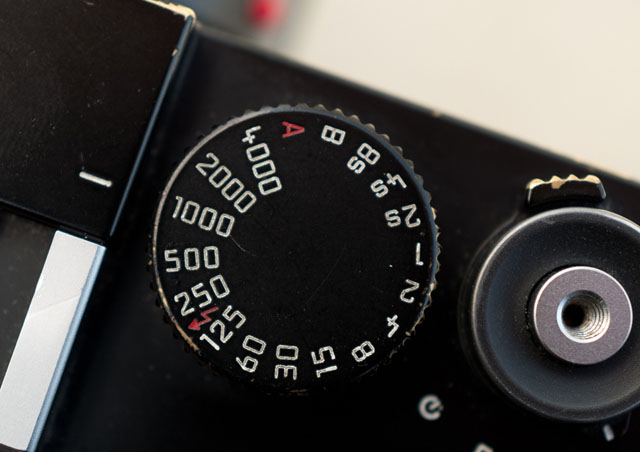
Shutter speed dial set to 1/1000 of a second.
| |
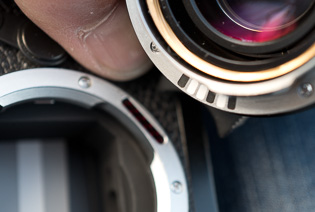 |
| |
The 6-bit code on the flange of the lens is read by the sensor on the Leica M bayonet of all digital Leica M cameras since 2006. © Thorsten Overgaard. |
| |
|
Six-bit code (6-bit code) - An engraving on the flange of M-lenses that makes it possible for digital M-cameras to recognize the lens that has been mounted. The camera can include information on the attached lens and its focal length in EXIF data and make digital corrections for lens-specific flaws, such as color-cast or vignetting. Six-bit coding was introduced for all M-lenses sold since 2006, but many older lenses can be retrofitted with the code at Leica Camera AG in Wetzlar.
SL = Abbreviation for Single-Lens as in the Leica SL that is a camera without reflex (mirror).
SLR = Abbreviation for Single-Lens Reflex; the lens that forms the image on the film/sensor also provides the image in the viewfinder via a mirror. Newer camera models has aen EVF (Electronic Viewfinder) that displays in the viewfinder what the sensor sees in real-time.
| |
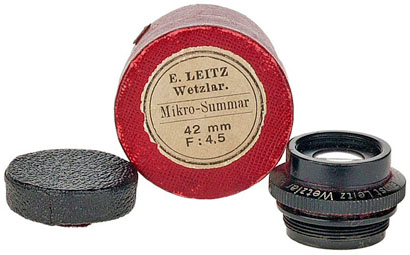 |
| |
Leitz Wetzlar Mikro-Summar 42mm f/4.5 lens anno 1910 might be the first lens carrying the name Summar. |
Summar - (or a story of name development)
The 1933 lens 50mm f2.0 Summar: It started out as Summar(f2.0), then the Summitar (f2.0 in 1939), then the Summarex(f1.5 in 1948), then the Summaron(35mm f.2.8 in 1948, then later f2.0, f3.5 and f5.6 lenses), then the Summarit (f1.5 in 1949 and used again for the 40mm f2.4 on the Leica Minilux in 1995, then again for the 35mm, 50mm, 75mm and 90mm Summarit f2.5 in 2007) then the Summicron(f2.0 in 1953 for the collabsible 50mm) and finally the Summilux(50mm f1.4 in 1959).
ORIGIN of Summar is unknown.
Summarex
The great thing about being a lens designer is that you get to name the lens. Dr. Max Berek who worked for Leitz from 1912 till his death in 1949 named lenses after his two favorite dogs. One was Sumamrex named after his dog Rex, the other Hektor named after his dog Hektor.
Summarit
Refers to the maximum lens aperture - here f/1.5.
Summicron = Refers to the maximum lens aperture - here f/2.0 . There are many guesses how this name came about, a popular one being that the "summi" came from "summit" (summit means the highest point of a hill or mountain; the highest attainable level of achievement) while the "cron" came from "chroma" (ie. for colour). Not so: The name (Summi)cron was used because the lens used Crown glass for the first time, which Leitz bought from Chance Brothers in England. The first batch of lenses were named Summikron (Crown = Krone in Deutsch). The Summi(cron) is a development from the orignal Summar (the 50mm f2.0 lens anno 1933). Vario-Summicron, Vario-Elmarit is Leica Camera AG's name for zoom lenses, for example the Vario-Summicron f/2.0 as the one that is on the Leica Digilux 2.
Summilux = Refers to the maximum lens aperture - here f/1.4 , "-lux" added for "light" (ie. the enhanced light gathering abilities). In Leica terminology a Summilux is always a f/1.4 lens and a Summicron is a f/2.0 lens.
Telyt
Lens nomenclature - short-hand for " telephoto " (tele- is a combining form, meaning to or at a distance) and used in names of instruments for operating over long distances : telemeter. The name has been used for a number of tele lenses from Leica.
ORIGIN: from Greek t?le- ‘far off.’
Three-dimensional = Having the three dimensions of height, width and depth. In photography and lens design, three-dimensional effect is also the perception of even small micro-details; the texture of skin can appear flat and dead or three-dimensional and alive. Also, selective focus (foreground and background out of focus) can change the perception of depth. Also see Perspective.
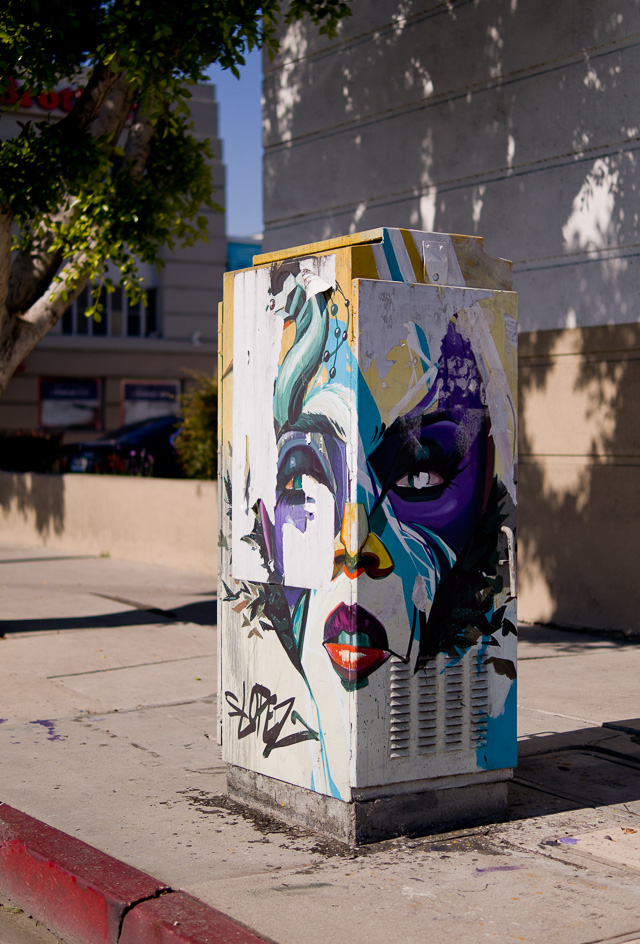
Three-dimensional = Having the three dimensions of height, width and depth. Melrose Avenue in Los Angeles. Leica TL2 with Leica 35mm Summilux-TL ASPH f/1.4. © 2017 Thorsten Overgaard.
Leica T is the compact camera developed by Leica Camera in 2014 as a touch-screen operated camera that can take the Leica L mount lenses made for this camera and the Leica SL and Leica CL. This camera series was names Leica TL later. See my article Compact Leica Cameras for more.
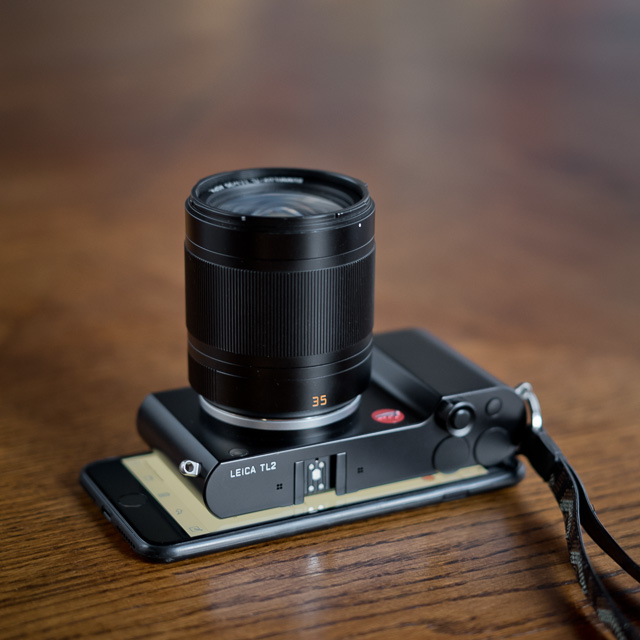
The Leica TL2 (2017) with a 35mm Summilux-L f/1.4 lens, compared with the Apple iPhone 7 Plus. © Thorsten Overgaard.
TTL
(T)hrough (T)he (L)ens light metering, usually WRT the flash metering capabilities built into the R6.2, R8, R9, M7 & M6TTL cameras.
V-Lux is a series of compact SLR-like digital cameras by Leica Camera AG developed with Panasonic since 2006, starting with the Leica V-Lux 1 (2006), V-Lux 2 (2010), V-Lux 3 (2011), V-Lux 4 (2012), V-Lux Typ 114 (2014), V-Lux 5 (2018). See my article "Compact Digital Leica Cameras".
To add confusion, Leica also made a Leica V-Lux 20 in 2010, V-Lux 30 in 2011 and a Leica V-Lux 40 in 2012 that was a temporarily renaming of the Leica C-Lux series.
Vario- is the Leica Camera AG name for zoom lenses. Vario-Elmarit, Vario-Elmar and Vario-Summicron and so on.
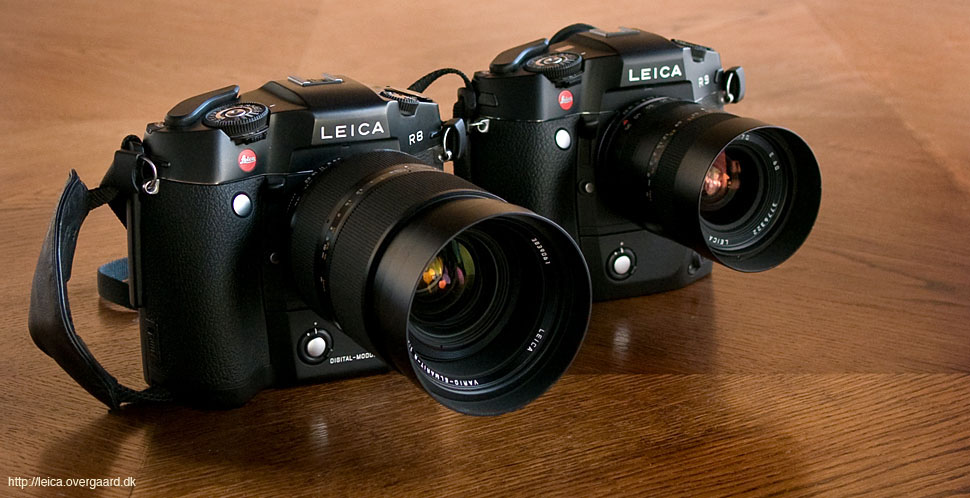
The Leica 35-70mm Vario-Elmarit-R f/2.8 ASPH (left) and the Leica 35-70mm Vario-Elmar-R ASPH f/4.0 (right)
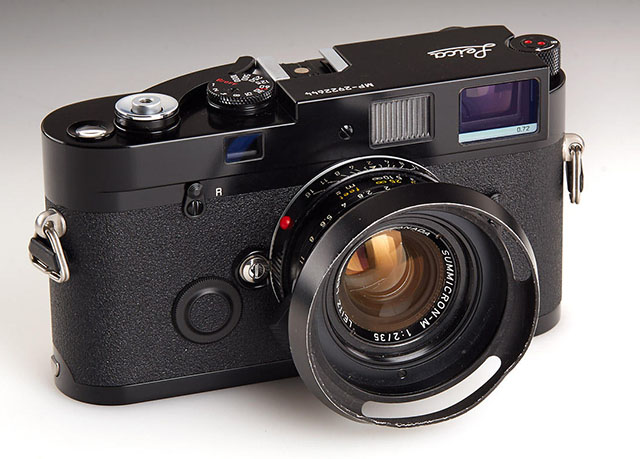
Ventilated shade on a 35mm of Elliott Erwitt's Leica MP camera.
Ventilated Shade - A shade is a hood in front of a lens that provides shade from light going straight onto the lens from outside what you are photographing, which could cause internal reflections like flare, which would make the picture less contrasty.
The ventilated shade has holes so it doesn't obstructs the view from the viewfinder. In many of today’s mirrorless cameras where there is no viewfinder looking ver the lens, so there is no actual need for a ventilated shade; but they are considered classic or vintage looking and are still in high demand. It makes no difference for the purpose of the shade (to create shadow) if it is ventilated or not.
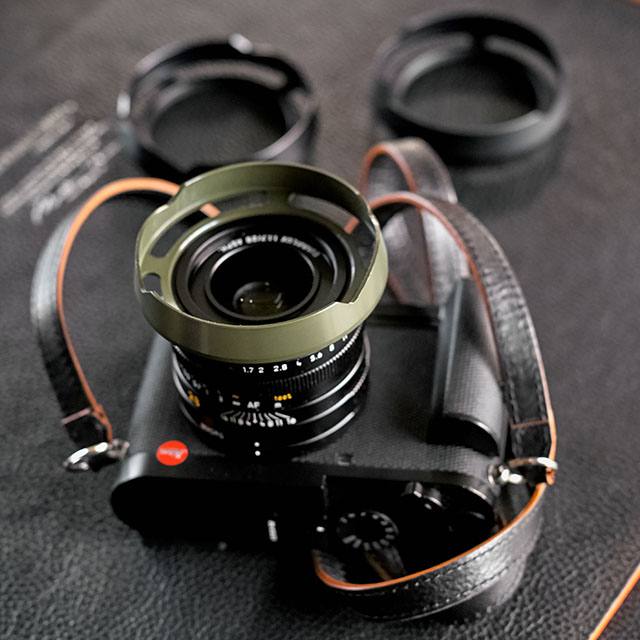
Ventilated Shade for the Leica Q. I make ventilated shades for most lenses and sell them from here.
Viewfinder a device on a camera showing the field of view of the lens. Also known as the German word "Messucher" (or Meßsucher).
1) A built-in viewfinder in a camera that simply show the frame you get when you look through the viewfinder.
2) A rangefinder viewfinder which is also used to focus the lens. In Leica M cameras two pictures has to meet and lay 'on top of each other' for the picture to be in focus.
3) An external viewfinder, usually on top of the camera in the flash shoe, so as to show the field of view of lenses vider than what the built-in viewfinder can show (15mm, 21mm, 24mm, 28mm etc viewfinders exist)
4) Very simple "aiming-devices" on top of a camera that is simply a metal frame without any optics. Just a frame, as for example very old cameras (the original Leica), or when using cameras in diving where you can't look through the camera.
5) A Electronic Viewfinder (EVF) that shows what the sensor sees "live".
WB = Short for White Balance:
White Balance = (often referred to as WB) in camera menus. See my aticle "Adjusting the White Balance in Photoraphy" for explanation, illustrations and examples.
WLAN = German short for WiFi. In camera menus, Leica may refer to WLAN, which is simply German for WiFi, (and for some reason they refuse to believe that the rest of the world doesn't call it for WLAN like they do). WLAN stands for wireless local area network.
X1 - The Leica X1 was released in September 2009, the Leica X2 in 2012, and Leica X Typ 113 was released in September 2014, all with a fixed 23mm f/1.7 lens. Leica X Vario Typ 107 and Leica X-E Typ 102 was released later. A Leica X-U underwater edition was released in 2026. See my article Compact Leica Cameras for more.
XML = Stands for extensible markup language, which is a way enclose information to a document about how to format it, and more.
XMP = Stands for extensible markup platform (also known as XMP sidecar) and is a standard developed by Adobe and standardized by the International Organization for Standardization ISO. XMP is a 'sidecar' to an image that contains the EXIF data (camera settings) as well as other data about the image recording and editing that would norally be in proprietary formats (only readable by certain software). XMP in short is a container enclosed with the image as a 'sidecar' that contains all available information (EXIF data about settings, IPTC data (who took the photo, copyright info, image captions, etc), but most noteable, the XMP allow you to include information about the editing that was performed to the raw or DNG file, so that when you open the image file in another editing software, the raw data, as well as information about the crop, exposure compensation and other editing you did to the photo, is included).
In Adobe Lightroom Classic, one should make sure to select that editing information is written to the XMP file of each image (go to Lightroom > Catalog Settings > Metadata and then click "Automatically write changes into XMP").
Zone System -A system of 11 greytones. Ansel Adams worked out the Zone System in the 1940's with Fred Archer. It may look as simply a grey scale (and it is) but it's the use that has troubled many. If you use a normal external light meter, it will give you the exact amount of light and you can expose your photograph based on that and it will be correct. 
What Ansel Adams basically did was that he studied (by measuring with a spot meter), what the exact grey tones were of the sky, the clouds, the sand, the water, the skin and so on at different times of the day.
You could say that he built up a conceptual understanding of how different materials of different colors and reflective surface would look in black and white at different times of day (or different light conditions). He also realized that a tone changes for the human eye depending on it's size and in which context of other tones it is seen.
In short, you could say that the Zone System is know how something would look in black and white when looking at a scenery. Some who have struggled with the Zone System have done so because they think it is a rule. It is not.
| How Ansel Adams made New Mexico look: |
|
How most people see New Mexico: |
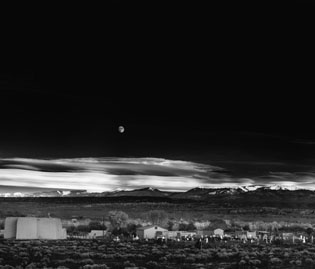 |
|
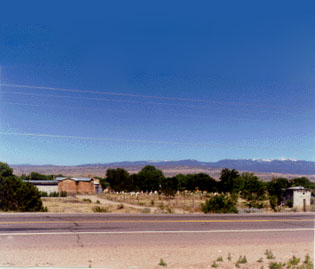 |
| The artistic use of the Zone System. |
Ansel Adams developed the Zone System to understand light for himself, but also as a fundament for teaching the light, exposure and making the final photograph. How will it look if you do the usual, and what will it look like if you manipulate it. But most interstingly; how do you work with light, cameras and photographic materials to achieve the look you envision.
The Zone System is meant as a basis on which to create your own aesthetic style and communication. Photography is painting with light. The greyscale is our palette. Ideally we should have a conceptual understanding of the tones and be able to use them intuitive. That was his vision for us all.
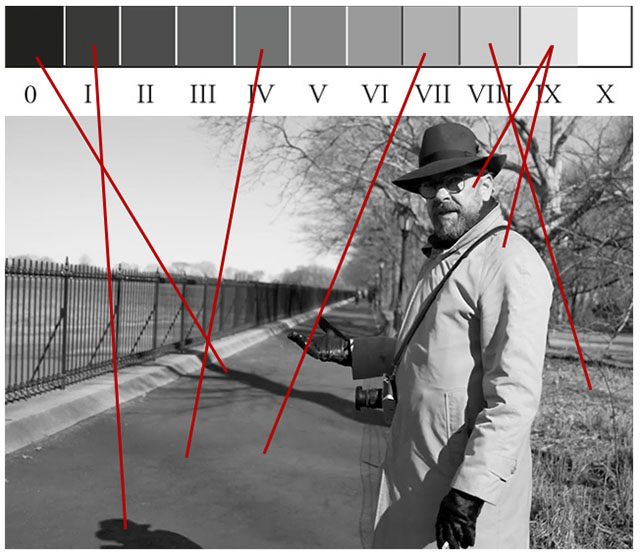
Thorsten Overgaard in New York, explaining the Zone System in his "Street Photography Masterclass".
Ø - Diameter. As in Ø49 for example which means that the filter diameter is 49mm for this lens (or if a filter is Ø49, it is 49mm in diameter and fits that Ø49 lens). Leica uses E to express their filters sizes, as in E49 for a 49mm filter size.
|
![]()
